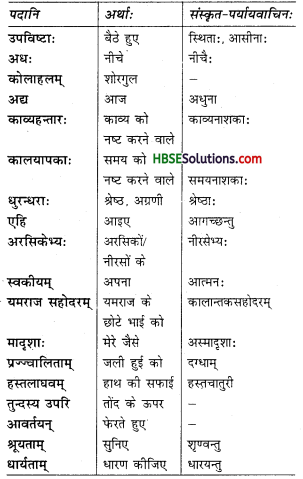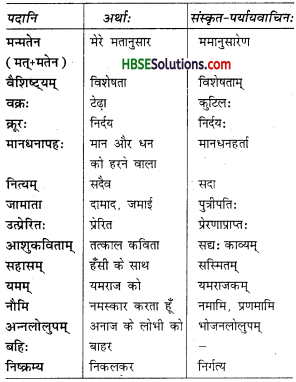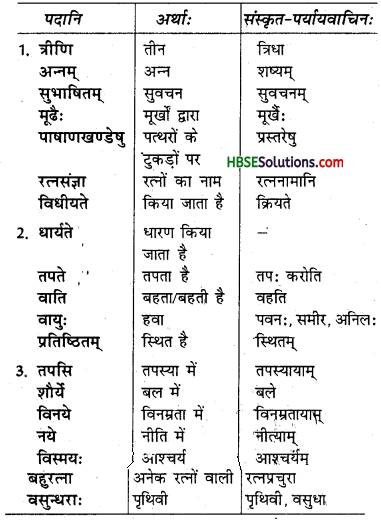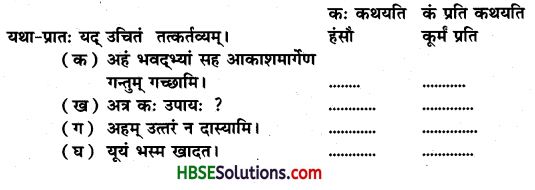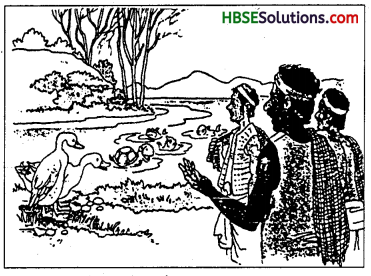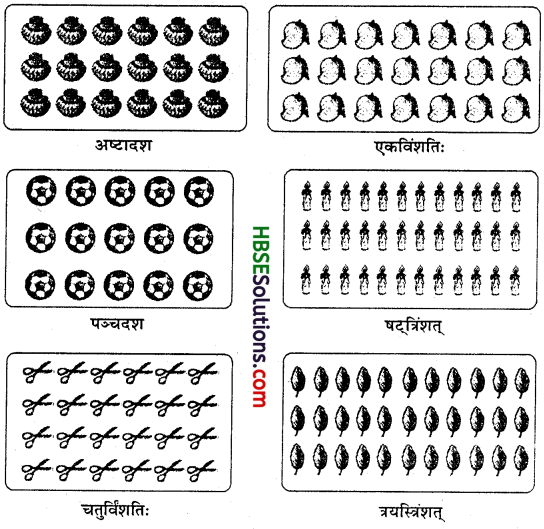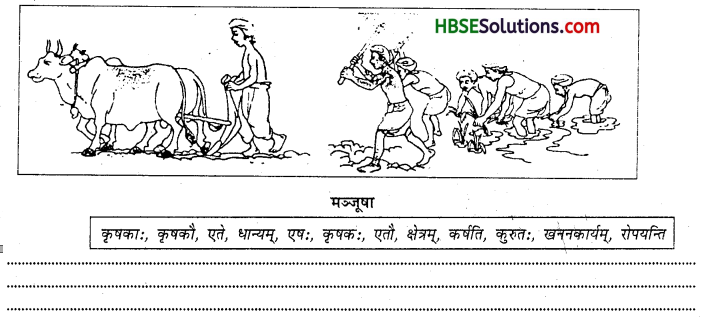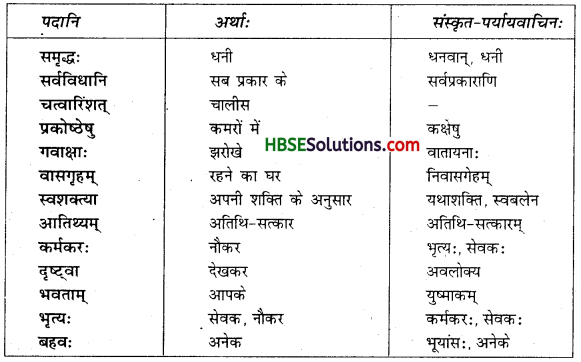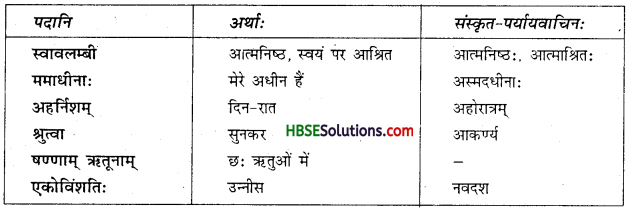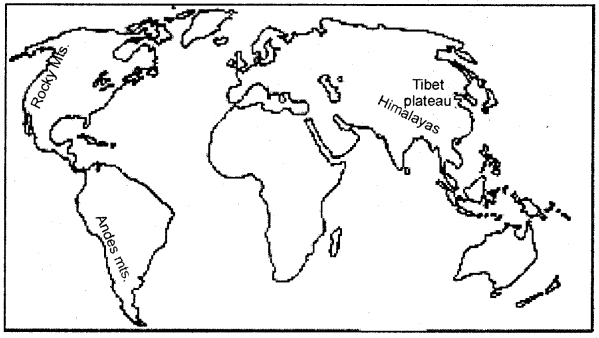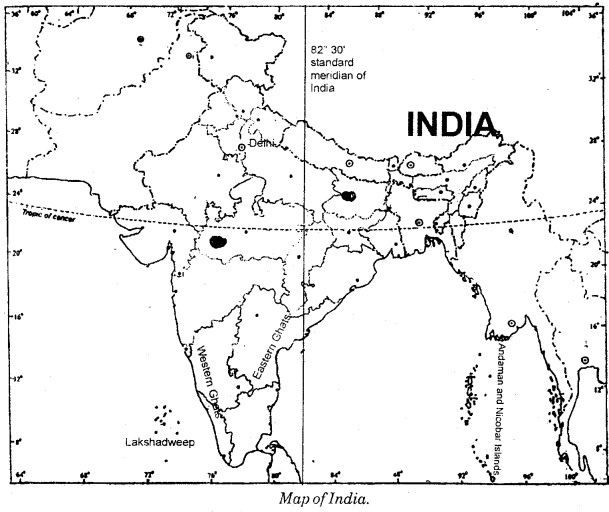Haryana State Board HBSE 12th Class English Solutions Vistas Chapter 2 The Tiger King Textbook Exercise Questions and Answers.
Haryana Board 12th Class English Solutions Vistas Chapter 2 The Tiger King
HBSE 12th Class English The Tiger King Textbook Questions and Answers
Question 1.
The story is a satire on the conceit of those in power. How does the author employ the literary device of dramatic irony in the story? (यह कहानी सत्ताधारी लोगों के घमण्ड पर व्यंग्य है। लेखक ने इस कहानी में नाटकीय विडम्बना का साहित्यिक तरीका किस प्रकार प्रयोग किया है ?)
Answer:
Dramatic irony is a device in which a character in a story, novel or play, is not aware of something which the reader or the spectator knows. The author of this story uses this device in order to bring the conceit of those in power. The astrologers had predicted that the Tiger King would be killed by a tiger. He was told that even if he had killed ninety-nine tigers, he could be killed by the hundredth tiger. So the king took a vow to kill one hundred tigers.
After killing ninety-nine tigers, he was on the lookout for the hundredth tiger. His dewan had an old pet tiger. He let that tiger out in the forest. The king did not know this fact. He shot that tiger, thinking that he had killed it. In fact, it had been killed by his hunter. It is a dramatic irony that the king thought himself safe. In fact, he had not killed the hundredth tiger. The king was killed by a wooden toy tiger in his own palace. The king was conceited and thought that he could escape his destiny. But he died in the same way as predicted by the astrologers.
(नाट्यात्मक व्यंग्य एक ऐसा ढंग है जिसमें किसी कहानी, उपन्यास या नाटक का एक पात्र उस बात के बारे में नहीं जानता है जो कि पाठक या दर्शक जानता है। इस कहानी का लेखक सत्ताधारी लोगों के घमंड को प्रदर्शित करने के लिए इस ढंग को अपनाता है। ज्योतिषियों ने इस बात की घोषणा की थी कि ‘बाघ राजा’ एक बाघ द्वारा ही मारा जाएगा। उसको यह बात बताई गई कि यदि उसने निन्यानवें बाघों को भी मार दिया तो सौवें बाघ के द्वारा उसे मार दिया जाएगा। इसलिए राजा ने एक सौ बाघों को मारने की प्रतिज्ञा ली। निन्यानवें बाघों को मारने के पश्चात्, उसको सौवें बाघ की तलाश थी। उसके दीवान के पास एक बूढ़ा पालतू बाघ था।
उसने उस बाघ को जंगल में छोड़ दिया। राजा को इस बात की सच्चाई नहीं पता थी। उसने उस बाघ को गोली मार दी और सोचने लगा कि उसने उस बाघ को भी मार दिया। वास्तव में वह बाघ उसके शिकारी के द्वारा मारा गया था। यह एक नाटकीय विडम्बना है कि राजा स्वयं को सुरक्षित समझ रहा था। वास्तव में उसने सौवें बाघ को नहीं मारा था। राजा उसके महल में ही एक खिलौने बाघ द्वारा मारा गया। राजा घमण्डी था और सोच रहा था कि वह अपनी किस्मत से बच जाएगा। लेकिन वह उसी ढंग से मारा गया जिस ढंग से ज्योतिषी ने उसकी मौत बताई थी।)
Question 2.
What is the author’s indirect comment on subjecting innocent animals to the willfulness of human beings? (मासूम जानवरों को मनुष्य की मनमौजी प्रवृत्ति का शिकार बनाने के बारे में लेखक की अप्रत्यक्ष टिप्पणी क्या है?)
Answer:
This story is a satire on the willfulness of man. He kills innocent animals just to satisfy his ego. The innocent animals live in the forests. They do not kill men. But man in order to satisfy his ego or willfulness goes on killing these animals. The Tiger King took a vow to kill one hundred tigers. He killed all the tigers in the forests of his own kingdom. Then he married a girl of a royal family.
After marriage, whenever he visited his father-in-law, he killed five or six tigers. Very soon all the tigers of his father-in-law’s kingdom were also killed. The British officers wanted to kill tigers just to satisfy their vanity. They killed tigers because they wanted to be photographed with the dead tiger. In this way, man’s willfulness leads to the death of innocent animals.
(यह कहानी मनुष्य की मनमौजी प्रवृति पर एक व्यंग्य है। वह केवल अपने अहम् को शांत करने के लिए निर्दोष जानवरों को मारता है। निर्दोष जानवर जंगलों में रहते हैं। वे इन्सानों को नहीं मारते हैं। लेकिन इन्सान अपने अहम् या मनमौजी प्रवृत्ति की संतुष्टि के लिए, पशुओं को मारता रहता है। बाघ राजा ने एक सौ बाघों को मारने का प्रण लिया। उसने अपने राज्य के जंगलों में पाए जाने वाले सभी बाघों को मार दिया।
तब उसने एक शाही परिवार की लड़की से शादी की। शादी के बाद, जब भी वह अपनी ससुराल में जाता था तो एक बार में वह पाँच या छः बाघों को मार दिया करता था। बहुत शीघ्र ही उसकी ससुराल के राज्य के भी सारे बाघ मार दिए गए। अंग्रेज अधिकारी केवल अपने घमण्ड की संतुष्टि के लिए ही बाघों को मार दिया करते थे। वे बाघों को मार देते थे क्योंकि वे मृत बाघों के साथ फोटो खिंचवाना चाहते थे। इस तरह से, मनुष्य की मनमौजी प्रवृत्ति निर्दोष जानवरों की मौत का कारण बनती है।)

Question 3.
How would you describe the behaviour of the Maharaja’s minions towards him? Do you find them truly sincere towards him or are they driven by fear when they obey him? Do we find a similarity in today’s political order? . (राजा के दासों का उसके प्रति व्यवहार का वर्णन आप किस प्रकार करेंगे। क्या आप उन्हें राजा के प्रति सचमुच वफादार पाते हैं या क्या वे केवल डर के कारण उसका कहना मानते हैं? क्या हमें आजकल की राजनीतिक प्रणाली में कोई समानता नजर आती है? )
Answer:
The behavior of the Maharaja’s minions towards him is that of flattery. They are not truly sincere towards him. They are driven by fear and self-interest when they obey the Maharaja. One of his minions is the dewan. He never gives any sincere advice to the king. He does not give advise the king that he should look after the interests of the kingdom and should not waste his time in killing tigers. He helps the king in finding a bride in the kingdom of whose father there are many tigers which the king can kill. He obeys the king of fear. The king tells him that he must find the hundredth tiger for him to kill. The dewan is afraid of the king’s anger, so he sacrifices his own pet tiger to satisfy the king’s whim. The political system of the Maharaja is similar to that in today’s world. We find that many people are flatterers of those in power. They change their loyalties with the change in governments.
(महाराजा के दासों का उसके प्रति व्यवहार चापलूसी-पूर्ण है। वे उसके प्रति सचमुच वफादार नहीं हैं। जब वे महाराजा की आज्ञा का पालन करते हैं तो वे भय या स्वार्थ भाव से भरे होते हैं। उसका एक दास दीवान है। वह कभी भी राजा को कोई सही सलाह नहीं देता है। वह राजा को यह सलाह नहीं देता है कि उसे अपने राज्य के हितों की देखभाल करने की ओर ध्यान लगाना चाहिए बाघों को मारने में अपना समय नहीं गँवाना चाहिए। वह राजा की एक ऐसी दुल्हन को खोजने में मदद करता है जिसके पिता के राज्य में बहुत सारे बाघ हैं जिन्हें महाराजा मार सकता है। वह डर के मारे राजा के आदेश का पालन करता है। राजा उससे कहता है कि वह उसके शिकार के लिए सौवें बाघ का प्रबन्ध करे। दीवान राजा के क्रोध से डरता है, इसलिए वह राजा के लिए अपने ही बाघ की बलि दे देता है। महाराजा की राजनीतिक व्यवस्था बिल्कुल आधुनिक संसार की राजनीतिक व्यवस्था के समान है। हम देखते हैं कि बहुत से लोग सत्ताधारी लोगों की चापलूसी करते हैं। वे सरकार के परिवर्तन के साथ ही अपनी निष्ठा को बदल लेते हैं।)
Question 4.
Can you relate instances of game-hunting among the rich and the powerful in the present times that illustrate the callousness of human beings towards wildlife? (क्या आप आज के जीवन से अमीर एवं शक्तिशाली लोगों में शिकार की घटनाएँ बता सकते हैं जो वन्य-जीवन के प्रति मनुष्य की निष्ठुरता को दर्शाती हैं?)
Answer:
Hunting is very common in the modern times also. The hunters are callous towards the wildlife. It is because of the ruthless hunting of wild animals that our wildlife is fast disappearing. There are only a few tigers left in the country. The elephant hunts kill the elephants mercilessly because of their tusks. Although there are wildlife sanctuaries yet we daily hear about the death of tigers.
The greedy and callous hunters don’t care for the depleting wildlife. The rhinoceros are also being ruthlessly killed daily. The horn of the rhino is used in medicines. That is why the rhinos are disappearing rapidly. The whale is the biggest animal on this earth. Yet man in his greed is killing whales daily. In the same way, other wild creatures are falling a prey to man’s greed. Some species of deer are killed for their skins and horns.
(आज के समय में भी शिकार करना बहुत आम बात है। शिकारी वन्य-जीवन के प्रति अति निष्ठुर हैं। जंगली जानवरों के अंधाधुंध शिकार की वजह से हमारा वन्य-जीवन बड़ी तेजी के साथ लुप्त होता जा रहा है। हमारे देश में बहुत ही कम संख्या में बाघ बचे हैं। हाथियों का शिकार करने वाले लोग बड़ी निर्दयता के साथ हाथियों का उनके दाँतों की वजह से शिकार करते हैं। यद्यपि हमारे देश में वन्य-जीव विहार हैं फिर भी हम हर रोज बाघों की मौत के बारे में सुनते रहते हैं। लालची और निष्ठुर शिकारी इस घटते हुए वन्य-जीवन की परवाह नहीं करते हैं। गेंडों का भी हर रोज अंधाधुंध शिकार किया जा रहा है। गेंडे के सींग का प्रयोग दवाइयों में किया जाता है। यही कारण है गेंडे तेजी से लुप्त होते जा रहे हैं। व्हेल इस पृथ्वी पर पाया जाने वाला सबसे बड़ा प्राणी है। फिर भी इन्सान अपने लालच में हर रोज व्हेल का शिकार कर रहा है। इसी प्रकार से कुछ अन्य जंगली जीव भी मनुष्य के लालच का शिकार होते जा रहे हैं। हिरण की कुछ प्रजातियों को उनकी खाल और सींगों के लिए मार दिया जाता है।)
Queen 5.
We need a new system for the age of ecology – a system which is embedded in the care of all people and also in the care of the Earth and all life upon it. Discuss. (हमें पर्यावरण के युग के लिए एक नई प्रणाली चाहिए-एक ऐसी प्रणाली जो लोगों की देखभाल में और धरती एवं इसके जीवन की देखभाल में निहित हो। विवेचना करो।)
Answer:
Our Indian culture considers all life on earth sacred. Our ancient scriptures preached that man and animals were all the creatures of the same God and so they both were sacred. Many animals have been considered sacred in our mythology. Some of them have been associated with gods and goddesses. Even plants and rivers are sacred in our culture. In the ancient times, man and animals existed together. Ashoka was the only king in the history of mankind who prohibited the killing of wild animals for food or pleasure.
In many parts of Rajasthan deer are considered sacred and are not killed. But in the modern times, we are forgetting these aspects of our ancient culture. We are not only killing the wild animals, we are polluting our environment also and disturbing the fragile ecological system of this earth. If our future generations are to survive, we must learn to preserve our wildlife and ecology.
(हमारी भारतीय संस्कृति पृथ्वी पर पाए जाने वाले प्रत्येक जीवन को पावन मानती है। हमारे पुरातन ग्रंथों ने इसी बात का उपदेश दिया है कि आदमी और जानवर सभी उस भगवान की रचना हैं इसलिए वे दोनों पवित्र हैं। हमारे पौराणिक ग्रंथों में बहुत से जानवरों को पवित्र माना गया है। उनमें से कुछ का संबंध तो देवी-देवताओं के साथ भी है। यहाँ तक कि हमारी संस्कृति में तो पौधों और नदियों को भी पवित्र माना गया है। प्राचीन कालों में, मनुष्य और पशु आपस में एक साथ रहते थे।
अशोक इतिहास का एक मात्र ऐसा राजा था जिसने भोजन या मनोरंजन के लिए जानवरों को मारने पर प्रतिबन्ध लगा दिया था। राजस्थान के कई हिस्सों में हिरण को पवित्र माना गया है और उन्हें मारा नहीं जाता है। लेकिन आधुनिक समय में, हम अपनी प्राचीन संस्कृति के इन पहलूओं को भूलते जा रहे हैं। हम न केवल जंगली जानवरों को मार रहे हैं, बल्कि हम अपने पर्यावरण को भी प्रदूषित करते जा रहे हैं और इस पृथ्वी की नाजुक पर्यावरण व्यवस्था को भी क्षति पहुँचाते जा रहे हैं। यदि हमारी भावी पीढ़ियों को जीवित रहना है, तो हमें अपने वन्य-जीवन और पर्यावरण को सुरक्षित रखने के तरीकों को अवश्य ही सीखना होगा।)
Read And Find Out
Question 1.
Who is the Tiger King? Why does he get that name? [H.B.S.E. 2017 (Set-C)] (बाघ राजा कौन है? उसे यह नाम किस प्रकार मिला?)
Answer:
The Tiger King is the Maharaja of Pratibandapuram. When he was an infant, an astrologer made a prophecy that when he grew up, he would be killed by a tiger. On hearing this, the infant let out a horrible growl. When he grew up, he started killing tigers. That is why he was nick-named the Tiger King.
(‘बाघ राजा’ प्रतिबन्दपुरम का महाराजा है। जब वह एक शिशु था, तो एक ज्योतिषी ने भविष्यवाणी की थी कि जब वह बड़ा होगा, तो वह एक बाघ के द्वारा मारा जाएगा। यह बात सुनकर, उस शिशु ने एक भयानक दहाड़ लगाई थी। जब वह बड़ा हो गया, तो उसने बाघों को मारना शुरू कर दिया। इसी कारण से उसका नाम ‘बाघ राजा’ पड़ गया।)
Question 2.
What did the royal infant grow up to be? (शाही शिशु बड़ा होकर किस प्रकार का बना?)
Answer:
The royal infant grew up to be a tall and strong young man. When he came to the age of twenty-one, he was made the king of his state. (शाही शिशु एक लंबे और शक्तिशाली नवयुवक के रूप में बड़ा हो गया। जब वह इक्कीस वर्ष का हो गया तो, उसे अपने राज्य का राजा बना दिया गया।)

Question 3.
What will the Maharaja do to find the required number of tigers to kill? (शिकार करने के लिए आवश्यक संख्या में बाघ प्राप्त करने के लिए महाराजा क्या करेंगे?) Or Why did the Maharaja decide to get married? [H.B.S.E. March, 2019 (Set-A)] (महाराजा ने शादी करने का निर्णय क्यो लिया?)
Answer:
The Maharaja wanted to kill one hundred tigers in order to escape the prophecy made by the astrologer. But there were not enough tigers left in his state. So he decided to marry a girl from the state in which there were enough tigers. By doing so he will have access to the tigers of that state also. (महाराजा ज्योतिषी द्वारा की गई भविष्यवाणी से बचने के लिए एक सौ बाघों को मारना चाहता था। लेकिन उसके राज्य में इतने बाघ नहीं बचे थे। इसलिए उसने उस राज्य की लड़की से शादी करने का निर्णय लिया जिसमें बहुत अधिक बाघ थे। ऐसा करके उसकी पहुंच उस राज्य के बाघों तक भी हो जाएगी।)
Question 4.
How will the Maharaja prepare himself for the hundredth tiger which was supposed to decided his fate? (उस सौवें बाघ का शिकार करने के लिए महाराजा स्वयं को किस प्रकार तैयार करेंगे जिससे उनकी तकदीर का फैसला होना था?)
Answer:
A prophecy had been made that the Maharaja would be killed by the hundredth tiger. In order to avoid that prophecy, he had decided to kill one hundred tigers. He had already killed ninety-nine tigers. He was told that a tiger visited the forest often. The Maharaja went to the forest. But the tiger was not visible. But the Maharaja was equally determined. He refused to leave the forest until the tiger was found.
(एक भविष्यवाणी की गई थी कि महाराजा सौवें बाघ के द्वारा मार दिया जाएगा। उस भविष्यवाणी से बचने के लिए उसने एक सौ बाघों को मारने का निर्णय लिया। वह पहले ही निन्यानवें बाघों को मार चुका था। उसे बताया गया कि एक बाघ प्रायः जंगल में आता रहता है। महाराजा जंगल में गया। लेकिन बाघ नजर नहीं आ रहा था। लेकिन महाराजा का निश्चय भी पक्का था। उसने तब तक जंगल से नहीं जाने का निर्णय लिया जब तक बाघ नहीं मिल जाता।)
Question 5.
What will now happen to the astrologer? Do you think the prophecy was indisputably disproved? (अब ज्योतिषी का क्या होगा? क्या उसकी भविष्यवाणी अटल रूप से गलत साबित हो जाएगी?)
Answer:
Nothing will happen to the astrologer. He will not be proved wrong. The Maharaja kills one hundred tigers. But then he will be killed when a quill of a wooden tiger pierces the Maharaja’s hand. (ज्योतिषी को कुछ नहीं होगा। वह गलत साबित नहीं होगा। महाराजा एक सौ बाघों को मारता है। लेकिन वह तब मारा जाता है जब एक लकड़ी के बाघ का छिलर महाराजा के हाथ को छेद देता है।)
HBSE Class 12 English The Tiger King Important Questions and Answers
Multiple Choice Questions
Select the correct option for each of the following questions :
1. Who is the writer of the story ‘The Tiger King’?
(A) Kalki
(B) Nalki
(C) Palki
(D) Halki
Answer:
(A) Kalki
2. Who is the main character in the story ‘The Tiger King’?
(A) Raja Salar Jung
(B) Shamsher Jung
(C) Diler Jung
(D) Jung Jung Bahadur
Answer:
(D) Jung Jung Bahadur
3. Which kingdom was ruled by Jung Jung Bahadur?
(A) Patliputra
(B) Pratibandapuram
(C) Patna
(D) Petersburg
Answer:
(B) Pratibandapuram
4. By what name was King Jung Jung Bahadur known?
(A) Elephant King
(B) Donkey King
(C) Tiger King
(D) Fox King
Answer:
(C) Tiger King
5. What miracle took place when the king was only ten days old?
(A) he began to dance
(B) he began to sing
(C) he began to write
(D) he began to speak
Answer:
(D) he began to speak

6. What did the child ask the astrologer to predict?
(A) the manner of his death
(B) the date of his marriage
(C) date of his divorce
(D) the future of his kingdom
Answer:
(A) the manner of his death
7. What did the astrologer predict about the death of the king when he was an infant?
(A) death by drowning
(B) death by a tiger
(C) death by his wife
(D) death by his enemy
Answer:
(B) death by a tiger
8. At what age did Jung Jung Bahadur become the king?
(A) ten years
(B) fifteen years
(C) thirty years
(D) twenty years
Answer:
(D) twenty years
9. What did Jung Jung Bahadur decide to do in order to save himself from the astrologer’s prediction?
(A) to kill the astrologer
(B) to kill the royal priest
(C) to kill all the tigers in Pratibandapuram
(D) to make friendship with the tigers
Answer:
(C) to kill all the tigers in Pratibandapuram
10. How many tigers should the king have, according to the astrologer?
(A) three hundred
(B) two hundred
(C) five hundred
(D) one hundred
Answer:
(D) one hundred
11. What ban was declared about the tigers by the king?
(A) only the king would kill them
(B) only his peon would kill them
(C) only his wife would kill them
(D) only the police would kill them
Answer:
(A) only the king would kill them
12. Who visited Pratibandapuram one day?
(A) a beautiful lady
(B) a high-ranking British officer
(C) the neighboring king
(D) a big elephant
Answer:
(B) a high-ranking British officer
13. How many rings did the king send to the British officer’s wife?
(A) forty
(B) thirty
(C) fifty
(D) sixty
Answer:
(C) fifty
14. How many tigers did the king kill in ten years?
(A) forty
(B) fifty
(C) sixty
(D) seventy
Answer:
(D) seventy
15. How did the king solve the problem of finding more tigers for killing?
(A) he brought tigers from America
(B) he married a girl from a royal family
(C) he demanded tigers in dowry
(D) he asked the tigers to come to be killed
Answer:
(B) he married a girl from a royal family

16. How many tigers did the king kill in his father-in-law’s kingdom?
(A) 29
(B) 39
(C) 49
(D) 59
Answer:
(A) 29
17. The sheep began to disappear from the forest. What did that mean?
(A) the sheep were leaving the forest
(B) the sheep were committing suicide
(C) there was a tiger in the forest
(D) someone was stealing sheep
Answer:
(C) there was a tiger in the forest
18. How did the dewan solve the problem of finding the tiger?
(A) he purchased a tiger for the king
(B) he asked a tiger to come
(C) he brought a tiger from another city
(D) he released his own pet tiger in the forest
Answer:
(D) he released his own pet tiger in the forest
19. What did the hunters find when they went near the tiger?
(A) the tiger was dead
(B) the tiger was not dead
(C) the tiger was dancing
(D) the tiger was laughing
Answer:
(B) the tiger was not dead
20. Who actually killed the tiger?
(A) the king
(B) the queen
(C) the prince
(D) one of the hunters
Answer:
(D) one of the hunters
Short Answer Type Questions
Question 1.
What miracle took place when the king was only ten days old? (जब राजा केवल दस दिन का था तो क्या चमत्कार हुआ?)
Answer:
When the King was born, his father called the famous astrologers of the kingdom in order to know the child’s future. At that moment, a great miracle took place. The child, who was only ten days old began to speak. He asked the astrologers to predict the manner of his death.
(जब राजा का जन्म हुआ, तो उसके पिता ने बच्चे का भविष्य जानने के लिए राज्य के प्रसिद्ध ज्योतिषियों को बुलाया। उसी समय, एक बहुत बड़ा चमत्कार घटित हुआ। वह बालक जो मात्र दस दिनों का था ने बोलना शुरू कर दिया। उसने ज्योतिषियों से पूछा कि उसकी मौत किस तरह से होगी।)
Question 2.
Why was the astrologers wonder struck? What prediction did he make? (ज्योतिषी हैरान क्यों हो गया? उसकी भविष्यवाणी क्या थी?) Or What does the chief Astrologer tell to be the cause of Maharaja’s death? (मुख्य ज्योतिषी ने महाराजा की मृत्यु का क्या कारण बताया?) [H.B.S.E. March, 2019 (Set-C)]
Answer:
The royal infant, who was only ten days old, started speaking. The chief astrologer was wonder struck to hear the infant speaking. Then he made a prediction that the child would be killed by a tiger.
(शाही शिशु, जो केवल दस दिनों का था ने बोलना शुरू कर दिया। प्रधान ज्योतिषी उस शिशु को बोलते हुए सुनकर अति हैरान था। तब उसने पूर्वानुमान किया कि उस बालक की मौत एक बाघ के द्वारा होगी।)
Question 3.
When did the king come to know the prediction about his death? (राजा को अपनी मौत की भविष्यवाणी का कब पता चला?)
Answer:
With the passage of time, the crown prince Jung Jung Bahadur grew up to be a strong young man. When he was twenty years old, he became the king. But everyone in the kingdom remembered the astrologer’s prediction about his death. Gradually it reached the Maharaja’s ears also.
(समय बीतने के साथ, वह शाही राजकुमार जिसका नाम जंग जंग बहादुर था एक शक्तिशाली नवयुवक के रूप में बड़ा हो गया। जब वह बीस वर्ष का था, तो वह राजा बन गया। लेकिन राज्य में हर किसी को उसकी मौत के बारे में ज्योतिषी की भविष्यवाणी याद थी। धीरे-धीरे यह बात महाराजा के कानों तक भी पहुंच गई।)

Question 4.
What did the king do after killing the first tiger? (राजा ने पहले बाघ को मारने के बाद क्या किया?)
Answer:
There were innumerable tigers in Pratibandapuram. So he decided to kill all of them so that his own life could be safe. When he killed the first tiger, he was very excited. He called the state astrologer and showed him the dead tiger.
(प्रतिबन्दपुरम में असंख्य बाघ थे। इसलिए उसने उन सभी को मारने का निर्णय लिया ताकि उसका अपना जीवन बच सके। जब उसने पहले बाघ का वध किया था तो वह बहुत उत्साहित था। उसने राजसी ज्योतिषी को बुलाया और उसे मृत बाघ दिखाया।)
Question 5.
What did the royal astrologer tell the king when he showed him the first tiger killed by him? (राजा ने अपने द्वारा मारा गया पहला बाघ शाही ज्योतिषी को दिखाया तो उसने क्या कहा?)
Answer:
The royal astrologer told the king that he might kill ninety-nine tigers in the same manner, but he must be very careful with the hundredth tiger. And if the king was able to kill it, he would be safe from tigers.
(राजसी ज्योतिषी ने उसे बताया कि वह इसी तरह से निन्यानवें बाघों को तो मार सकता है लेकिन उसे सौवें बाघ से सचेत रहना चाहिए। और यदि राजा सौवें बाघ को भी मार देगा, तो वह बाघों से सुरक्षित हो जाएगा।)
Question 6.
What vow did the king take? [H.B.S.E. 2017 (Set-D)] (राजा ने क्या कसम खाई?)
Answer:
The king took a vow that he would attend to the other matters of state only after killing the hundredth tiger. (राजा ने कसम खाई कि वह राज्य के अन्य सभी काम सौवें बाघ को मारने के बाद ही करेगा।)
Question 7.
Why did the high-ranking British officer want to kill tigers? Did the king grant him permission? (उच्च-स्तरीय ब्रिटिश अधिकारी बाघ क्यों मारना चाहता था? क्या राजा ने उसे अनुमति दी?)
Answer:
Once a high-ranking British officer visited Pratibandapuram. He was very fond of hunting tigers. More than killing a tiger, he liked to be photographed with the tiger whom he had killed. But the Maharaja refused to grant him permission.
(एक बार एक उच्च स्तरीय ब्रिटिश अधिकारी प्रतिबन्दपुरम आया। उसे बाघों का शिकार करने का बहुत शौक था। बाघों को मारने से भी अधिक उसे अपने द्वारा मारे गए बाघों के साथ फोटो खिंचवाने का शौक था। लेकिन महाराजा ने उसको अनुमति देने से मना कर दिया।)
Question 8.
Why was the king in the danger of losing his throne? (राजा को अपना सिंहासन खोने का खतरा क्यों हुआ?)
Answer:
The British officer wanted to shoot a tiger. But the king refused to grant him permission. Then the British officer said that he only wanted to be photographed with the dead tiger. But the king did not agree even to that proposal. Because he had prevented a British officer from fulfilling his desire, the Maharaja was in danger of losing his throne.
(ब्रिटिश अधिकारी एक बाघ का शिकार करना चाहता था। लेकिन राजा ने उसे अनुमति प्रदान करने से मना कर दिया। तब अंग्रेज अधिकारी ने कहा कि वह तो मृत बाघ के साथ केवल मात्र फोटो खिंचवाना चाहता है। लेकिन राजा इस प्रस्ताव पर भी सहमत नहीं हुआ। क्योंकि उसने अंग्रेज अधिकारी को बाघ का शिकार करने से रोका था इसलिए महाराजा को अपनी राजगद्दी खोने का खतरा था।)
Question 9.
How was the crisis to the king’s throne averted? (राजा के सिंहासन का खतरा कैसे टल गया?)
Or
How did the Maharaja manage to save this throne? [H.B.S.E. March, 2018 (Set-A)] (राजा ने अपने सिंहासन को बचाने का प्रबंध कैसे किया?)
Answer:
The king thought of a plan. He got fifty diamond rings from a British jeweller in Calcutta. He sent these to the British officer’s wife. He expected that she would select one or two rings and return the rest. But she kept all of them. But the crisis to his throne was averted.
(राजा ने एक योजना सोची। उसने कलकत्ता के एक अंग्रेज स्वर्णकार से हीरे की पचास अंगूठियाँ लीं। उसने ये अंगूठियाँ अंग्रेज अधिकारी की पत्नी के पास भेज दीं। उसे उम्मीद थी कि वह उनमें से एक या दो अंगूठियाँ रख लेगी और बाकी वापस कर देगी। लेकिन उसने उन सभी को रख लिया। लेकिन राजगद्दी पर आया संकट टल गया।)
Question 10.
How did the king solve the problem of finding more tigers for him to hunt? (राजा ने अपने शिकार के लिए अधिक बाघ ढूँढने की समस्या कैसे हल की?) or What was the unforeseen hurdle that brought the Maharaja’s tiger hunt to a halt? (अप्रत्याशित बाधा क्या थी जिसने महाराजा के बाघ के शिकार को रोक दिया?) [H.B.S.E. March, 2019 (Set-D)]
Answer:
The king continued hunting the tigers. Within ten years, he killed seventy tigers. The tigers population in his state became extinct. In order to solve this problem, the Maharaja married a girl from a royal family in whose kingdom there was a large tiger population.
(राजा ने बाघों का शिकार करना जारी रखा। दस वर्षों के अंदर ही, उसने सत्तर बाघों को मार दिया। उसके राज्य में बाघों की संख्या लुप्त हो गई। इस समस्या को हल करने के लिए, महाराजा ने एक राजसी परिवार की कन्या के साथ शादी कर ली, जिसके राज्य में बाघों की एक बड़ी संख्या पाई जाती थी।)

Question 11.
What happy news did the king get about the hundredth tiger? (राजा को सौवें बाघ के बारे में क्या प्रसन्न समाचार मिला?)
Answer:
The king killed ninety-nine tigers. Now only one more tiger remained to be killed to achieve a tally of a hundred. But now no tiger was left in the kingdom. Soon there came a happy news. In his own state, the sheep began to disappear frequently from a hillside village. It meant that there was a tiger which was eating up the sheep. The Maharaja became happy on hearing this news.
(राजा ने निन्यानवें बाघों को मार दिया। इसलिए एक सौ की संख्या तक पहुँचने के लिए एक और बाघ शेष रहता था। लेकिन अब उसके राज्य में कोई भी बाघ नहीं बचा था। शीघ्र ही एक प्रसन्नता भरा समाचार आया। उसके अपने राज्य में, पहाड़ी के पास वाले एक गाँव से बार-बार भेड़ें गायब होने लगीं। इसका अर्थ था कि वहाँ एक बाघ था जो कि भेड़ों को खा रहा था। इस समाचार को सुनकर महाराजा प्रसन्न हो गया।)
Question 12.
Why did the king set up his camp in the forest? (राजा ने जंगल में कैम्प क्यों लगा लिया?)
Answer:
The news came that there was a tiger in the forest. The king was keen to kill the hundredth tiger. So the Maharaja went to the forest and set up his camp there. But no tiger was seen. The king became annoyed. He called the dewan and spoke to him angrily.
(जंगल में एक बाघ के होने का समाचार आया। राजा सौवें बाघ का शिकार करने को उत्सुक था। इसलिए महाराजा जंगल में गया और उसने वहाँ अपना कैंप लगा लिया। लेकिन कोई बाघ दिखाई नहीं दिया। राजा नाराज हो गया। उसने दीवान को बुलाया और उसके साथ गुस्से से बात की।)
Question 13.
How did the dewan arrange the hundredth tiger for the king to shoot down? (दीवान ने राजा के शिकार के लिए सौवें बाघ का इंतजाम कैसे किया?) [H.B.S.E. March, 2018 (Set-B)]
Answer:
The dewan knew that if the king did not find the tiger, he would lose his job. The dewan had an old and pet tiger hidden in his house. At midnight, he and his wife put that tiger in a car and took him into the jungle where the king was camping. There they pushed him out of the car and came away.
(दीवान जानता था कि यदि राजा को बाघ नहीं मिला तो उसे अपनी नौकरी से हाथ धोना पड़ेगा। दीवान ने अपने घर में एक बूढ़ा और पालतू बाघ छुपाकर रखा हुआ था। रात के समय, उसने और उसकी पत्नी ने उस बाघ को अपनी कार में डाला और उसे जंगल में ले गए जहाँ राजा ने डेरा डाला हुआ था। वहाँ उन्होंने उसे कार से बाहर धकेला और चले गए।)
Question 14.
What did king announce after shooting at the hundredth tiger? (राजा ने सौवें बाघ को मारने के बाद क्या घोषणा की?)
Answer:
The next day, the Maharaja saw that tiger and shot at him. The tiger collapsed. The king was very happy. He ordered that the dead tiger should be taken to the kingdom in a procession. Then he went away in his car.
(अगले दिन, महाराजा ने बाघ को देखा और उस पर गोली चला दी। बाघ जमीन पर गिर गया। राजा बहुत खुश था। उसने आदेश दिया कि मृत बाघ को एक जुलूस के रूप में उसके राज्य में ले जाए। तब वह अपनी कार में सवार होकर चला गया।)
Question 15.
What did the hunters do with the ‘hundredth tiger’ after the Maharaja had left? (महाराजा के जाने के पश्चात् शिकारियों ने सौवें बाघ का क्या किया?)
Answer:
After the Maharaja had gone, the hunters accompanying him went near the tiger. They found that the tiger was not dead. The bullet had missed him. The tiger had fainted from the shock. But they dared not tell this secret to the king. One of the hunters shot at the tiger and killed him.
(जब महाराजा चला गया, तो महाराजा के साथ आए शिकारी बाघ के पास आए, उन्होंने देखा कि बाघ मरा नहीं था। गोली बाघ को नहीं लगी थी। बाघ तो सदमे की वजह से बेहोश हुआ था। लेकिन उनमें यह रहस्य राजा को बताने का साहस नहीं था। उनमें से एक शिकारी ने बाघ पर गोली चला दी और उसे मार दिया।)
Question 16.
What did the king decide to gift his son on his third birthday? [H.B.S.E. 2018 (Set-D)] (राजा ने अपने बेटे को उसके तीसरे जन्मदिन पर क्या उपहार देने का फैसला किया?)
Answer:
A few days later, the third birthday of the Maharaja’s son was celebrated. The king saw a wooden tiger in a shop and decided to give it to his son as a gift.
(कुछ दिनों के पश्चात्, महाराजा के बेटे का तीसरा जन्मदिन मनाया गया। राजा ने एक दुकान में लकड़ी का एक बाघ देखा और उसे अपने बेटे को उपहार में देने का निर्णय लिया।)
Question 17.
How did the king die? (राजा कैसे मरा?)
Answer:
The skin of the wooden tiger was rough and was covered with slivers like quills. One of the slivers pierced the king’s hand. By next day, the wound became infected. Soon the infection spread all over his right arm. Three surgeons performed the operation upon him. But the king died. In this way, the hundredth tiger took the king’s life.
(उस लकड़ी के बाघ की त्वचा खुरदरी थी और उस पर काँटों जैसी छिलरें थीं। एक काँटा राजा के हाथ में चुभ गया। अगले दिन, उस घाव में संक्रमण हो गया। शीघ्र ही वह संक्रमण पूरी दाँई बाजू में फैल गया। तीन सर्जनों ने राजा के घाव का ऑपरेशन किया। लेकिन राजा मर गया। इस तरह बाघ ने राजा का जीवन ले लिया।)
Long Answer Type Questions
Question 1.
How did the king of Pratibandapuram got the nick-name the ‘Tiger King’? (प्रतिबन्दपुरम के राजा का उपनाम ‘बाघ राजा’ कैसे पड़ा?) OR Who was Tiger King ? How did he get that name? [H.B.S.E. March, 2018 (Set-C)] (बाघ राजा कौन था? उसे यह नाम किस प्रकार मिला?)
Answer:
The Tiger King is the maharaja of Pratibandapuram. When the king of Pratibandapuram was born, his father called the famous astrologers of the kingdom in order to know the child’s future. At that moment, a great miracle took place. The child, who was only ten days old began to speak. He told the astrologers that people are born have to die one day. Then he asked the astrologers to predict the manner of his death. The chief astrologer was wonder-struck to hear the infant speaking. Then he said that the child would be killed by a tiger. At this, the infant let out a terrifying growl and said, “Let tigers beware!”
With the passage of time, the crown prince Jung Jung Bahadur grew up to be a strong young man. When he was twenty years old, he became the king. But everyone in the kingdom remembered the astrologer’s prediction. Gradually it reached the Maharaja’s ears also. There were innumerable tigers in Pr So he decided to kill all of them so that his own life could be safe. Therefore, the king came to be called the Tiger King.
(‘बाघ राजा’ प्रतिबन्दपुरम का महाराजा है। जब प्रतिबन्दपुरम के राजा का जन्म हुआ, तो उसके पिता ने बच्चे के भविष्य के बारे में जानकारी हासिल करने के लिए राज्य के प्रसिद्ध ज्योतिषियों को बुलवाया। उस समय, एक बहुत बड़ा चमत्कार हुआ। वह बालक जो मात्र दस दिन की उम्र का था ने बोलना शुरू कर दिया। उसने ज्योतिषियों को बताया कि लोग तो एक दिन मरने के लिए ही पैदा होते हैं। तब उसने ज्योतिषियों से कहा कि वे उसकी मौत के बारे में भविष्यवाणी करें। मुख्य ज्योतिषी उस शिशु को बोलते हुए सुनकर हैरान था। तब उसने कहा कि उस बालक की मौत एक बाघ के द्वारा होगी। इस पर उस शिशु ने भयंकर गर्जना की और कहा, “बाघों को अपनी खैर मनाने दो।”
समय बीतने के साथ, राजसी बालक जंग जंग बहादुर एक शक्तिशाली नवयुवक के रूप में बड़ा हुआ। जब उसकी उम्र बीस वर्ष की थी, वह राजा बन गया। लेकिन राज्य में हर कोई ज्योतिषी की भविष्यवाणी के बारे में जानता था। धीरे-धीरे यह बात महाराजा के कानों तक पहुंच गई। प्रतिबन्दपुरम में असंख्य बाघ पाए जाते थे। इसलिए उसने उन सभी बाघों को मारने का निर्णय लिया ताकि उसका अपना जीवन सुरक्षित रह सके। इसलिए उस राजा को ‘बाघ राजा’ के नाम से पुकारा जाने लगा।)

Question 2.
Why did the king take a vow to kill one hundred tigers? [H.B.S.E. 2020 (Set-A)7 (राजा ने सौ बाघों को मारने का प्रण क्यों लिया?)
Answer:
The state astrologer had predicted that the king would be killed by a tiger. So the king decided to kill all the tigers in his kingdom. When he killed his first tiger, he was very excited. He called the state astrologer and showed him the dead tiger. The astrologer told the king that he might kill ninety-nine tigers in the same manner, but he must be very careful with the hundredth tiger. And if the king was able to kill it, he would be safe from tigers.
From that day, the king banned tiger hunting in the state except by the Maharaja. The king took a vow that he would attend to the other matters of state only after killing the hundredth tiger. Sometimes the king faced dangers while hunting the tigers. But every time he was able to kill the tiger.
(राजसी ज्योतिषी ने भविष्यवाणी की थी कि राजा को एक बाघ के द्वारा मारा जाएगा। इसलिए राजा ने अपने राज्य के सभी बाघों को मारने का निर्णय लिया। जब उसने अपने पहले बाघ का शिकार किया था, तो वह अति उत्साही था। उसने राजसी ज्योतिषी को बुलाया और मृत बाघ उसे दिखाया। ज्योतिषी ने राजा को बताया कि वह इस तरह से निन्यानवें बाघों को मार सकता है, लेकिन उसको सौवें बाघ के बारे में सावधान रहना होगा। और यदि राजा उसे मारने में सफल रहा, तो वह बाघों से सुरक्षित रहेगा। उस दिन से, राजा ने स्वयं के अतिरिक्त अन्य हर किसी के लिए राज्य में बाघों का शिकार करने पर प्रतिबन्ध लगा दिया। राजा ने प्रतिज्ञा ली कि वह राज्य का कोई भी अन्य काम तब करेगा जब वह सौवें बाघ को मार देगा। कई बार तो बाघों का शिकार करते समय राजा को खतरों का सामना करना पड़ा। लेकिन हर बार वह बाघ को मारने में सफल रहा।)
Question 3.
When did the Tiger King stand in danger of losing his kingdom ? How was he able to avert the danger ? [H.B.S.E. March, 2019 (Set-A)] (टाइगर राजा कब अपने राज्य को खोने के खतरे में खड़ा था? वह खतरे को टालने में कैसे सक्षम था?)
OR
How did the tiger King bribe the British officer to save his kingdom? [H.B.S.E. March, 2018 (Set-C)] (किस प्रकार बाघ राजा ने अपनी राजधानी बचाने के लिए अंग्रेज अधिकारी को रिश्वत दी?) [H.B.S.E. 2019 (Set-B)]
Answer:
Once there was a crisis and the Maharaja was in danger of losing the throne. A high-ranking British officer visited Pratibandapuram. He was very fond of hunting tigers. More than killing a tiger, he liked to be photographed with the tiger whom he had killed. But the Maharaja refused to grant him permission. Then the British officer said that he only wanted to be photographed with the dead tiger.
But the king did not agree even to that proposal. Because he had prevented a British officer from fulfilling his desire, the Maharaja was in danger of losing his throne. The king thought of a plan. He got fifty diamond rings from a British jeweler in Calcutta. He sent these to the British officer’s wife. He expected that she would select one or two rings and return the rest. But she kept all of them. But the crisis to his throne was averted.
(एक बार एक संकट आ गया और महाराजा पर अपनी गद्दी खोने का खतरा मंडराने लगा। एक उच्च स्तरीय अंग्रेज अधिकारी प्रतिबन्दपुरम के दौरे पर आया। उसे बाघों का शिकार करने का बहुत शौक था। बाघ को मारने से भी अधिक, अपने द्वारा मारे गए बाघ के साथ फोटो खिंचवाने का शौक था। लेकिन महाराजा ने उसे अनुमति प्रदान करने से मना कर दिया। तब अंग्रेज अधिकारी ने कहा कि वह केवल मात्र मृत बाघ के साथ फोटो खिंचवाना चाहता है।
लेकिन राजा उस प्रस्ताव पर भी सहमत नहीं हुआ। क्योंकि उसने एक अंग्रेज अधिकारी को अपनी इच्छा पूरी करने से रोक दिया था, इसलिए महाराजा पर अपनी राजगद्दी खोने का संकट आ गया था। राजा ने एक योजना सोची। उसने कलकत्ता के एक अंग्रेज स्वर्णकार से हीरे की पचास अंगूठियाँ लीं। उसने ये अंगूठियाँ अंग्रेज अधिकारी की पत्नी के पास भेज दीं। उसे उम्मीद थी कि वह उनमें से एक या दो अंगूठियाँ रख लेगी और शेष वापस कर देगी। लेकिन उसने वे सभी रख लीं। लेकिन उसके राज्य पर आया संकट टल गया।)
Question 4.
Give a brief account of killing of ninety-nine tigers by the king. [H.B.S.E. 2017 (Set-A)] (राजा द्वारा निन्यानवें बाघों को मारने का संक्षिप्त वर्णन करो।)
Answer:
The king continued hunting the tigers. Within ten years, he killed seventy tigers. The tiger population in his state became extinct. In order to solve this problem, the Maharaja married a girl from a royal family in whose kingdom there was a large tiger population. Each time he visited the kingdom of his father-in-law, he killed five or six tigers. He killed twenty-nine more tigers, making the total number of tigers killed by him to be ninety-nine.
Now only one more tiger remained to be killed to achieve a tally of a hundred. But now no tiger was left even in his father-in-law’s kingdom. But soon there came a happy news. In his own state, the sheep began to disappear frequently from a hillside village. It meant that there was a tiger which was eating up the sheep. The Maharaja became happy on hearing this news.
(राजा ने बाघों का शिकार करना जारी रखा। दस वर्षों के अन्दर ही, उसने सत्तर बाघों को मार दिया। उसके राज्य में बाघ लुप्त हो गए। इस समस्या को हल करने के लिए, महाराजा ने शाही परिवार की एक कन्या से शादी कर ली जिसके राज्य में बहुत सारे बाघ थे। हर बार जब भी वह अपने ससुर के राज्य में जाता तो वह पाँच या छः बाघ मार कर आता था। उसने उन्नतीस बाघ और मार दिए, अपने द्वारा मारे गए बाघों की संख्या को निन्यानवें तक पहुंचा दिया।
इसलिए सौ के आँकड़े को छूने के लिए एक और बाघ को मारना शेष रह गया था। परंतु अब उसके ससुर के राज्य में कोई भी बाघ नहीं बचा था। लेकिन शीघ्र ही एक खुशखबरी आई। उसके अपने ही राज्य में, पहाड़ी के पास वाले एक गाँव से बार-बार भेड़ें गायब होने लग गईं। इसका अर्थ था कि वहाँ एक बाघ था जो भेड़ों को खा रहा था। इस समाचार को सुनकर राजा अति प्रसन्न हो गया।)
Question 5.
Did the king really kill the hundredth tiger? How did the king die? (क्या राजा ने सचमुच सौवें बाघ को मारा? राजा की मृत्यु कैसे हुई?) OR How did Tiger King meet his end ? [H.B.S.E. March, 2019 (Set-D)] (राजा अपने अंत तक कैसे पहुँचा?)
OR
How did the hundredth tiger take its revenge upon the Tiger King. [H.B.S.E. 2020 (Set-D)] (सौवें बाघ ने बाघ राजा से अपना बदला कैसे लिया?)
Answer:
When Maharaja did not find any tiger in the forest, he called the dewan and spoke to him angrily. The dewan knew that if the king did not find the tiger, he would lose his job. He had an old and pet tiger hidden in his house. At midnight, he put that tiger in the forest. The next day, the Maharaja saw that tiger and shot at him. The tiger collapsed. The king ordered that the dead tiger should be taken to the kingdom in a procession. Then he went away in his car.
After he had gone, the hunters accompanying him found that the tiger was not dead. The bullet had missed him. The tiger had fainted from the shock. But they dared not tell this secret to the king. One of the hunters shot at the tiger and killed him. The tiger was buried and a tomb was erected over his grave.
A few days later, the third birthday of the Maharaja’s son was celebrated. The king saw a wooden tiger in a shop and decided to give it to his son as a gift. The skin of the wooden tiger was rough and was covered with slivers like quills. One of the slivers pierced the king’s hand. By next day, the wound became infected. Soon the infection spread all over his right arm. Three surgeons performed the operation upon him. But the king died. In this way, the hundredth tiger took the king’s life.
(जब महाराजा को जंगल में कोई बाघ नहीं मिला, तो उसने दीवान को बुलाया और उससे गुस्से से बात की। दीवान जानता था कि यदि राजा को बाघ नहीं मिला तो वह अपनी नौकरी खो देगा। उसने अपने घर में एक बूढ़ा और पालतू बाघ छुपा कर रखा हुआ था। रात के समय, उसने उस बाघ को जंगल में छोड़ दिया। महाराजा ने बाघ को देखा और उस पर गोली चला दी। बाघ जमीन पर गिर गया। राजा ने आदेश दिया कि मृत बाघ को एक जुलूस के रूप में उसके राज्य में ले जाया जाए। तब वह अपनी कार में सवार होकर चला गया।
उसके जाने के बाद, उसके साथ आए शिकारियों ने देखा कि बाघ मरा नहीं था। उसे गोली लगी ही नहीं थी। बाघ तो केवल सदमे में ही बेहोश हो गया था। लेकिन उनमें यह रहस्य राजा को बताने का साहस नहीं था। एक शिकारी ने बाघ पर गोली चला दी और उसे मार दिया। बाघ को दफना दिया गया और उसकी कब्र के ऊपर एक समाधि बना दी गई।
कुछ दिनों के पश्चात्, महाराजा के बेटे का तीसरा जन्मदिन मनाया गया। राजा ने एक दुकान में लकड़ी का एक बाघ देखा और उसे उपहारस्वरूप अपने बेटे को देने का निर्णय लिया। लकड़ी के बाघ की त्वचा खुरदरी थी और उस पर काँटों जैसी छिलरें थीं। एक काँटा राजा के हाथ में चुभ गया। अगले दिन तक, उस घाव में संक्रमण हो गया। शीघ्र ही संक्रमण उसकी पूरी बाजू में फैल गया। तीन सर्जनों ने उसका ऑपरेशन किया। लेकिन राजा मर गया। इस तरह से, सौवें बाघ ने राजा का जीवन ले लिया।)

The Tiger King Summary in English and Hindi
The Tiger King Introduction to the Chapter
This story is about the Maharaja of Pratibandapuram. His name was Jung Jung Bahadur. But he was known by the name ‘Tiger King’. There is a long story as to how he came to be known as the ‘Tiger King’. At the time of the king’s birth, the royal astrologer predicted that the king would be killed by a tiger. When Jung Jung Bahadur became the king, he started killing tigers. The astrologer told him that he would be safe if he killed hundred tigers. The king killed ninety-nine tigers. But unknown to him, the hundredth tiger escaped his bullet but was killed by the royal hunter. The king was killed when he was playing with a toy tiger made of wood.
(यह कहानी प्रतिबंदपुरम के महाराजा के विषय में है। उसका नाम जंग जंग बहादुर था। लेकिन वह ‘टाईगर किंग’ के नाम से जाना जाता था। इसके बारे में एक लंबी कहानी है कि उसको ‘टाईगर किंग’ के नाम से क्यों जाना जाता था। राजा के जन्म के समय, राजसी ज्योतिषी ने भविष्यवाणी की थी कि राजा की मौत एक बाघ के हाथों होगी। जब जंग जंग बहादुर राजा बना, उसने बाघों को मारना शुरू कर दिया। ज्योतिषी ने उसे बताया कि यदि उसने एक सौ बाघों को मार दिया तो वह सुरक्षित रहेगा। राजा ने निन्यानवें बाघों को मार दिया। लेकिन उसकी जानकारी में न होने के कारण सौवाँ बाघ उसकी गोली से तो बच गया लेकिन उसको राजसी शिकारी के द्वारा मार दिया गया। राजा उस समय मारा गया जब वह लकड़ी से बने एक खिलौना बाघ के साथ खेल रहा था।)
The Tiger King Summary
This story is about the Maharaja of Pratibandapuram. His name was Jung Jung Bahadur. But he was known by the name ‘Tiger King’. There is a long story as to how he came to be known as the ‘Tiger King’. When the Tiger King was born, then his father called the famous astrologers of the kingdom in order to know that how the child’s future will be. The astrologers spoke out that the child born under this star would one day have to meet its death. At that moment, a great miracle took place. The child, who was only ten days old began to speak. He told the astrologers that people are born have to die one day. Then he asked the astrologers to predict the manner of his death. The chief astrologer was wonder struck to hear the infant speaking.
Then he said that the child would be killed by a tiger. At this the infant let out a terrifying growl and said, “Let tigers beware !” With the passage of time, the crown prince Jung Jung Bahadur grew up to be a strong young man. When he was twenty years old , he became the king. But everyone in the kingdom remembered the astrologer’s prediction. Gradually it reached the Maharaja’s ears also. There were innumerable tigers in Pratibandapuram. So he decided to kill all of them so that his own life could be safe. When he killed the first tiger, he was very excited. He called the state astrologer and showed him the dead tiger. The astrologer told the king that he might kill ninety-nine tigers in the same manner, but he must be very careful with the hundredth tiger. And if the king was able to kill it, he would be safe from tigers.
From that day, the king banned tiger hunting in the state except by the Maharaja. The king took a vow that he would attend to the other matters of state only after killing the hundredth tiger. Sometimes the king faced dangers while hunting the tigers. But everytime he was able to kill the tiger. Once there was a crisis and the Maharaja was in danger of losing his throne. A high-ranking British officer visited Pratibandapuram. He was very fond of hunting tigers.
More than killing a tiger, he liked to be photographed with the tiger whom he had killed. But the Maharaja refused to grant him permission. Then the British officer said that he only wanted to be photographed with the dead tiger. But the king did not agree even to that proposal. Because he had prevented a British officer from fulfilling his desire, the Maharaja was in danger of losing his throne. The king thought of a plan. He got fifty diamond rings from a British jeweller in Calcutta. He sent these to the British officer’s wife. He expected that she would select one or two rings and return the rest. But she kept all of them. But the crisis to his throne was averted.
The king continued hunting the tigers. Within ten years, he killed seventy tigers. The tigers population in his state became extinct. In order to solve this problem, the Maharaja married a girl from a royal family in whose kingdom there was a large tigers population. Each time he visited the kingdom of his father-in-law, he killed five or six tigers. He killed twenty-nine more tigers, making the total number of tigers killed by him to be ninety-nine. Now only one more tiger remained to be killed to achieve a tally of a hundred. But now no tiger was left even in his father-in-law’s kingdom. But soon there came a happy news. In his own state, the sheep began to disappear frequently from a hillside village.
It meant that there was a tiger which was eating up the sheep. The Maharaja became happy on hearing this news. The Maharaja went to the forest and set up his camp there. But no tiger was seen. The king became annoyed. He called the dewan and spoke to him angrily. The dewan knew that if the king did not find the tiger, he would lose his job. The dewan had an old and pet tiger hidden in his house. At midnight, he and his wife put that tiger in a car and took him into the jungle where the king was camping. There they pushed him out of the car and came away. The next day, the Maharaja saw that tiger and shot at him. The tiger collapsed. The king was very happy. He ordered that the dead tiger should be taken to the kingdom in a procession. Then he went away in his car.
After the Maharaja had gone, the hunters accompanying him went near the tiger. They found that the tiger was not dead. The bullet had missed him. The tiger had fainted from the shock. But they dared not tell this secret to the king. One of the hunters shot at the tiger and killed him. The tiger was carried in a grand procession. He was buried and a tomb was erected over his grave.

A few days later, the third birthday of the Maharaja’s son was celebrated. The king saw a wooden tiger in a shop and decided to give it to his son as a gift. The skin of the wooden tiger was rough and was covered with slivers like quills. One of the slivers pierced the king’s hand. By next day, the wound become infected. Soon the infection spread all over his right arm. Three surgeons performed the operation upon him. But the king died. In this way, the hundredth tiger took the king’s life.
(यह कहानी प्रतिबंदपुरम के राजा के विषय में है। उसका नाम जंग जंग बहादुर था। लेकिन उसको ‘टाइगर किंग’ के नाम से जाना जाता था। इसके पीछे एक लंबी कहानी है कि वह ‘टाइगर किंग’ के नाम से क्यों जाना गया। जब टाईगर किंग का जन्म हुआ, तो उसके पिता ने राज्य के प्रसिद्ध ज्योतिषियों को यह जानने के लिए बुलाया कि बच्चे का भविष्य कैसा होगा। ज्योतिषियों ने बता दिया कि इस सितारे के नीचे जन्म होने के कारण बच्चे को एक दिन मौत का सामना करना पड़ेगा। उसी क्षण, एक बड़ा चमत्कार हुआ। केवल दस दिन पहले जन्मे उस बच्चे ने बोलना शुरू कर दिया। उसने ज्योतिषियों से कहा कि जो भी लोग जन्म लेते हैं उन्हें एक दिन मरना ही पड़ता है। उसने ज्योतिषियों से अपनी मृत्यु के तरीके के बारे में भविष्यवाणी करने को कहा। प्रधान ज्योतिषी बच्चे को बोलता हुआ सुनकर हक्का-बक्का रह गया। तब उसने कहा कि बच्चे की मौत बाघ के द्वारा होगी। इस बात पर नवजात शिशु ने एक डरावनी गुर्राहट प्रकट की और कहा, “बाघों को सावधान होने दो!”
समय के बीतने के साथ, राजकुमार जंग जंग बहादुर एक शक्तिशाली नवयुवक के रूप में बड़ा हो गया। जब वह बीस वर्ष का था, वह राजा बन गया। लेकिन राज्य में हर कोई ज्योतिषी की भविष्यवाणी को जानता था। धीरे-धीरे वह महाराजा के कानों तक भी पहुंच गई। प्रतिबंदपुरम में असंख्य बाघ थे। इसलिए उसने उन सभी बाघों को मारने का निर्णय लिया ताकि उसका स्वयं का जीवन सुरक्षित रह सके। जब उसने पहले बाघ को मारा, वह बहुत उत्तेजित था। उसने राजसी ज्योतिषी को बुलाया और उसको मृत बाघ दिखाया। ज्योतिषी ने राजा को बताया कि वह निन्यानवें बाघों को इसी प्रकार से मार सकता है लेकिन सौवें बाघ को मारते समय उसको अति सावधान रहना चाहिए और यदि राजा ने उसे भी मार दिया, तो वह बाघों से सुरक्षित रहेगा। उस दिन से राजा ने महाराजा के अतिरिक्त किसी अन्य के द्वारा बाघों के शिकार पर प्रतिबंध लगा दिया। राजा ने शपथ उठाई कि वह सौवें बाघ को मारने के पश्चात् ही राज्य के अन्य कार्यों में अपना ध्यान लगाएगा। कई बार बाघों का शिकार करते समय राजा को कठिनाइयों का सामना करना पड़ता था। लेकिन हर बार वह बाघ को मारने में सफल रहता था।
एक बार एक संकट आ गया और महाराजा को अपना सिंहासन खोने का खतरा था। एक ऊँचे दर्जे का अंग्रेज अधिकारी प्रतिबंदपुरम की यात्रा पर आया। उसे बाघों के शिकार का बड़ा शौक था। बाघ को मारने से भी अधिक उसे बाघ के साथ फोटो खिंचवाने का बड़ा शौक था जो उसने मारा था। लेकिन महाराजा ने उसे अनुमति देने से मना कर दिया। तब अंग्रेज अधिकारी ने कहा कि वह तो केवल एक मृत बाघ के साथ फोटो खिंचवाना चाहता है। लेकिन राजा उस प्रस्ताव पर भी सहमत नहीं हुआ। क्योंकि उसने एक अंग्रेज अधिकारी को अपनी इच्छा पूरी करने से रोका था, तो महाराजा के ऊपर अपना सिंहासन खो देने का खतरा था। राजा ने एक योजना सोची। उसने कलकत्ता के एक अंग्रेज सुनार से हीरे की पचास अंगूठियाँ खरीदीं। उसने ये अंग्रेज अधिकारी की पत्नी को भेज दीं। उसने सोचा था कि वह उनमें से एक या दो अंगूठियाँ पसंद कर लेंगी और शेष वापिस भेज देंगी। लेकिन उसने उन सभी को रख लिया। लेकिन उसके सिंहासन का खतरा टल गया।
राजा ने बाघों का शिकार करना जारी रखा। दस वर्षों के अंदर-अंदर उसने 70 बाघों को मार दिया। उसके राज्य में बाघों की संख्या लुप्त हो गई। इस समस्या को हल करने के उद्देश्य से, महाराजा ने एक ऐसे शाही परिवार की कन्या के साथ शादी कर ली जिनके राज्य में बाघों की संख्या बहुत अधिक थी। हर बार जब वह अपने ससुर के राज्य की सैर पर आता, तो वह पाँच या छह बाघ मार देता। उसने उन्नतीस और बाघों को मार दिया और उसके द्वारा मारे गए कुल बाघों की संख्या निन्यानवें हो गई और अब सौ के आँकड़े को छूने के लिए एक और बाघ को मारे जाने की आवश्यकता थी। लेकिन अब उसके ससुर के राज्य में भी एक भी बाघ नहीं बचा था। लेकिन शीघ्र ही एक प्रसन्नता भरा समाचार आया। उसके अपने ही राज्य में, पहाड़ी के पास में बसे एक गाँव से भेड़ें अचानक ही गायब होनी शुरू हो गईं। इसका अर्थ था कि वहाँ एक बाघ था जो भेड़ों को खा रहा था। यह समाचार सुनकर महाराजा प्रसन्न हो गया।
महाराजा जंगल में गया और वहाँ अपना शिविर स्थापित कर लिया। लेकिन कोई भी बाघ दिखाई नहीं दिया। राजा क्रोधित हो गया। उसने दीवान (महामंत्री) को बुलाया और उससे गुस्से से बात की। दीवान जानता था कि यदि राजा को बाघ नहीं मिला, तो उसकी नौकरी चली जाएगी। दीवान ने अपने घर में एक वृद्ध और पालतू बाघ को छुपाकर रखा था। आधी रात के समय, उसने और उसकी पत्नी ने उस बाघ को एक कार में डाला और उसे जंगल में ले गया जहाँ राजा का शिविर लगा था। वहाँ उन्होंने उसे कार से बाहर धकेल दिया और आ गए। अगले दिन, महाराजा ने बाघ को देखा और उस पर गोली चला दी। बाघ जमीन पर गिर गया। राजा बड़ा खुश था। उसने आदेश दिया कि मृत बाघ को एक जुलूस के रूप में उसके राज्य में ले जाया जाए। तब वह अपनी कार में चला गया।
महाराजा के जाने के पश्चात्, शिकारी बाघ के पास गए। उन्होंने देखा कि बाघ तो मरा नहीं है। गोली उसे लगी ही नहीं थी। बाघ तो सदमे के कारण बेहोश हो गया था। लेकिन उन्होंने यह रहस्य राजा को बताने का साहस नहीं दिखाया। उनमें से एक शिकारी ने बाघ पर गोली चला दी और उसे मार दिया। बाघ को एक भव्य जुलूस के रूप में ले जाया गया। उसे दफनाया गया और उसकी कब्र के ऊपर एक मकबरा बनाया गया। कुछ दिनों के पश्चात्, महाराजा के बेटे का तीसरा जन्म दिवस मनाया गया। राजा ने एक दुकान में लकड़ी से बना एक बाघ देखा और उसे अपने बेटे को उपहार देने का निर्णय लिया। लकड़ी के बाघ की त्वचा खुरदरी थी और वह साही के तकवों जैसी काँटों से भरी थी। उनमें से एक काँटा राजा के हाथ में चुभ गया। अगले दिन तक, घाव में संक्रमण हो गया। शीघ्र ही संक्रमण उसकी पूरी दाईं बाजू में फैल गया। तीन शल्य चिकित्सकों ने उसका ऑप्रेशन किया। लेकिन राजा मर गया। इस प्रकार, सौवें बाघ ने राजा की जान ले ली।)
The Tiger King Word Meanings
[Page 8] :
Identified (recognized)= पहचाना;
shortened (made short)= छोटा किया;
pretending (feigning) = दिखावा करना;
advance (to move forward) = आगे बढ़ना;
strategic (of great importance) = अधिक महत्ता;
withdrawal (retreat) = पीछे हटना;
throw off track (to divert)= ध्यान भंग करना;
imperative (necessary)= आवश्यक;
disclose (reveal) = व्यक्त करना;
vital (important) = महत्त्वपूर्ण;
indomitable (unyielding) = दृढ़-निश्चयी।
[Page 9] :
Abode (dwelling place) = रहने का स्थान;
evealed (disclosed)= उजागर किया;
fantastic (fanciful) = अजीबोगरीब;
aspect (view) = दृश्य;
demise (death) = मौत;
astrologers (soothsayers) = भविष्यवक्ता;
foretold (predicted) = भविष्यवाणी की;
warrior (fighter) = योद्धा;
swallowed (ate without chewing) = निगलना;
miracle (marvel) = चमत्कार;
astonishing (surprising) = हैरानीपूर्ण;
emerged (came out) = बाहर आया;
prophets (foretellers) = भविष्यवक्ता;
transfixed (stood still) =शान्त खड़ा रहा;
stupefaction (astonished) = भौंचक्का ;
blinked (winked) = पलक झपकाई;
infant (baby) = शिशु;
enunciated (pronounced) = उच्चारण किया;
spectacles (glasses) = चश्मा;
gazed (looked intentely) ध्यान से देखा;
intently (earnestly) = गम्भीरता से;
predictions (forecasts) = भविष्यवाणी;
squeaky (in a shrill voice) तीखी आवाज में;
barely (hardly) = मुश्किल से ही;
incredible (hard to believe) = अविश्वसनीय।

[Page 10] :
Quake (tremble) = काँपना;
pronounced (uttered)= बोला;
growl (roar) = दहाड़ना;
terrifying (frightening) = भयभीत करने वाला;
beware (be careful) = सावधान रहना;
rumour (hearsay) = अफवाह;
rife (widespread) = सब जगह फैला;
hindsight (guess as to what happened)= अंदाजा लगाना कि क्या हुआ था;
conclude (infer) = निष्कर्ष निकालना;
marked (distinguished)=महत्त्वपूर्ण;
nanny (nurse) = नस /दाइ;
came of age (become mature)= परिपक्व होना;
innumerable (countless) = अनगिनत;
thrilled (excited)= उत्तेजित;
demanded (wanted to know) = जानना चाहा ।
[Page 11]:
Tuft (bunch of hair) बालों का गुच्छा;
incoherent = (disconnected) = अलग-अलग;
celebration (festivity) = उत्सव;
banned (prohibited) = निषेधित;
fling (throw)= फेंकना;
confiscate (seize)= जब्त करना;
(took an oath)= कसम खाना;
initially (in the beginning) = आरम्भ में।
[Page 12] :
Resolve (determination) = इरादा;
carcass (dead body )= लाश;
relented (softened)= नरम पड़ गया;
deliberations (discussions) = विचार-विमर्श;
despatched (sent)= भेजा;
forthwith (immediately) = फारन;
expensive (costly)= महाँगा;
retain (keep)= रखना;
unforeseen (unexpected)= अप्रत्याशित;
hurdle(barrier)= बाधा;
mission (specified aim) = खास लक्ष्य;
standstill (stop) = रुका;
extinct (ended abruptly) = एकदम समाप्त हुआ।
[Page 13] :
Committed (did)= किया;
harakiri (suicide)= आत्महत्या;
brandishing (waving)= हिलात हुए;
shuddering (trembling) = काँपते हुए;
summoned (sent for) = बुलाया;
babble (childish talk) = बचकाना बातें;
ancestor (forefathers)= पूर्वज;
crack (splitting sound)= टूटने की आवाज;
statistics (statement by figures)= आकड़;
investigate (inquire into)= खोज करना;
adorned (decorated)= सजाना।
[Page 14]:
Anxiety (worry) = चिन्ता;
pitch (height) = तीखापन;
tally (amount) = माब्रा;
locate (discover the place of) = स्थान ढूँढना;
savage (cruel) = क्रूर;
wary (cautious)= सचत, सावधान;
dispelled (removed)= हटटाया;
ascertain (to find out) = पता लगाना;
wantonly (willfully) = मनमजी सं;
flout (disobey) = अवज्ञा करना; गुस्सा;
obstinacy (stubbornness)= जिद्द;
mounted (increased) = बढ़ा;
rage (anger)= गुस्सा।
[Page 15]:
Discontented (dissatisfied) = असन्तुष्ट;
convinced (persuaded)= मनाया;
shoved (pushed) = धकेला;
dragged (pulled) = खींचा;
catastrophic (disastrous) = विपत्तिपूर्ण;
launched (started) = आरम्भ किया;
thoroughly (completely)= पूरी तरह;
haul (pull)= खींचा;
supplication (prayer)= प्रार्थना;
command (order) = आदेश;
boundless (unlimited)= असीमित;
crumpled (shrunk)= सिकुड़ गया;
vow (oath)= कसम;
elation (joy) = खुशी;
bafflement (confusion) = उथल-पुथल;
fainted (became unconscious) बेहोश हो गया।

[Page 16] :
Tomb(grave )= कब्र;
erected (built)= बनाया;
entire (whole)= पूर्ण;
spotted (noticed)= देखा;
anna (an old Indian coin)= एक पुराना सिक्का ।
[Page 17]:
Carved (cut into shape) = आकृति बनाना;
unskilled (untrained) = अप्रशिक्षित;
slivers (thin and needle like) पतला एवं सूई की तरह का;
quills (pricks of a porcupine) = साही के कांटे;
flared (spread) = फैल गया;
suppurating (having pus) = मवाद पड़ जाना।
The Tiger King Translation in Hindi
I
Before You Read What is the general attitude of human beings towards wild animals? (मानव जाति का अन्य जीवों के प्रति सामान्य दृष्टिकोण क्या है?)
The Maharaja of Pratibandapuram is the hero of this story. He may be identified as His Highness Jamedar-General, Khiledar-Major, Sata Vyaghra Samhari, Maharajadhiraja Visva Bhuvana Samrat, Sir Jilani Jung Jung Bahadur, M.A.D., A.C.T.C., or C.R.C.K. But this name is often shortened to the Tiger King.
(प्रतिबन्दपुरम का महाराजा इस कहानी का नायक है। उसकी पहचान महान् जमींदार जनरल, खिलेदार मेजर, सत व्यग्र समहारी महाराजाधिराज विस्व भुवन सम्राट, सर जिलानी जंग जंग बहादुर, M.A.D.,A.C.T.C., या C.R.C.K. के रूप में भी की जा सकती है। परन्तु यह नाम प्रायः छोटा करके बाघ राजा कह दिया जाता है।)
I have come forward to tell you why he came to be known as Tiger King. I have no intention of pretending to advance only to end in a strategic withdrawal. Even the threat of a Stuka bomber will not throw me off track. The Stuka, if it likes, can beat a hasty retreat from my story.
(मैं आपको यह बताने के लिए आया हूँ कि उसे बाघ राजा के रूप में क्यों जाना जाने लगा। मेरा ऐसा कोई इरादा नहीं है कि मैं केवल आगे बढ़ने का दिखावा करके कहानी का सोचा-समझा अन्त कर दूँ । स्टुका बॉमर की धमकी भी मुझे अपने पथ से विचलित नहीं कर सकती। स्टुका यदि चाहे तो मेरी कहानी से हट सकता है।)
Right at the start, it is imperative to disclose a matter of vital importance about the Tiger King. Everyone who reads of him will experience the natural desire to meet a man of his indomitable courage face-to-face. But there is no chance of its fulfillment. As Bharata said to Rama about Dasaratha, the Tiger King has reached that final abode of all living creatures. In other words, the Tiger King is dead.
(शुरू में ही, बाघ राजा के बारे में एक महत्त्वपूर्ण बात को बताना जरूरी है। जो कोई भी उसके बारे में पढ़ता है वह एक अदम्य साहस वाले आदमी से आमने-सामने मिलने की स्वाभाविक इच्छा का अनुभव करेगा। लेकिन इसके पूर्ण होने का अवसर नहीं है। जैसे कि भरत ने राम से दशरथ के बारे में कहा था, बाघ राजा भी सभी जीवों की अन्तिम अवस्था में पहुँच चुका है। दूसरे शब्दों में, बाघ राजा मर चुका है।)
The manner of his death is a matter of extraordinary interest. It can be revealed only at the end of the tale. The most fantastic aspect of his demise was that as soon as he was born, astrologers had foretold that one day the Tiger King would actually have to die.
(उसकी मृत्यु का मामला बहुत अधिक रुचिकर है। यह केवल कहानी के अन्त में ही उजागर किया जा सकता है। उसकी मृत्यु का सबसे मजेदार पहलू यह था कि जैसे ही वह पैदा हुआ, तो ज्योतिष शास्त्रियों ने बताया कि एक दिन बाघ राजा तो अवश्य मरेगा।)
“The child will grow up to become the warrior of warriors, hero of heroes, champion of champions. But…” they bit their lips and swallowed hard. When compelled to continue, the astrologers came out with it. “This is a secret which should not be revealed at all. And yet we are forced to speak out. The child born under this star will one day have to meet its death.”
(“यह बच्चा बड़ा होकर योद्धाओं का योद्धा, नायकों का नायक, विजेताओं का विजेता बनेगा। परन्तु……….” उन्होंने अपने होठ बन्द किए और रहस्य को पी गए। जब बताते रहने के लिए बाध्य किया, तो ज्योतिषियों ने बताया। “यह एक राज है जिसे बिल्कुल भी उजागर नहीं करना चाहिए। और फिर भी हमें बोलने के लिए मजबूर किया गया है। इस ग्रह के नीचे पैदा हुआ बच्चा एक दिन जरूर अपनी मृत्यु से मिलेगा।”)
At that very moment, a great miracle took place. An astonishing phrase emerged from the lips of the ten-day-old Jilani Jung Jung Bahadur, “O wise prophets!” Everyone stood transfixed in stupefaction. They looked wildly at each other and blinked. “O wise prophets! It was I who spoke.” This time there were no grounds for doubt. It was the infant born just ten days ago who had enunciated the words so clearly. The chief astrologer took off his spectacles and gazed intently at the baby.
(ठीक उसी क्षण एक महान् चमत्कार हुआ। दस दिन की उम्र के जिलानी जंग जंग बहादुर के होठों से एक हैरान कर देने वाला वाक्यांश निकला, “ओ बुद्धिमान् भविष्यवक्ताओ!” हर कोई भौंचक्का होकर खड़ा रहा। उन्होंने एक-दूसरे की तरफ पागलों की तरह देखा और पलकें झपकाईं। “ओ बुद्धिमान् भविष्यवक्ताओ! यह मैं बोला था।” इस बार शक का कोई आधार नहीं था। यह केवल दस दिन पहले ही पैदा हुआ बच्चा था जिसने इतनी स्पष्टता से शब्दों का उच्चारण किया था। मुख्य ज्योतिषी ने अपने चश्मे उतारे और बड़े ध्यान से बच्चे को देखा।)
“All those who are born will one day have to die. We don’t need your predictions to know that. There would be some sense in it if you could tell us the manner of that death,” the royal infant uttered these words in his little squeaky voice.
(“वो सभी जो पैदा होते हैं उन्हें एक दिन मरना पड़ेगा। हमें यह जानने के लिए आपकी भविष्यवाणी की जरूरत नहीं है। यदि आप हमें इस मृत्यु का ढंग बता पाते तो इस बात में कोई तर्क होगा,” शाही शिशु ने ये शब्द अपनी पतली आवाज में कहे।)
The chief astrologer placed his finger on his nose in wonder. A baby barely ten days old opens its lips in speech! Not only that, but it also raises intelligent questions! Incredible! Rather like the bulletins issued by the war office, than facts. The chief astrologer took his finger off his nose and fixed his eyes upon the little prince. “The prince was born in the hour of the Bull. The Bull and the Tiger are enemies, therefore, death comes from the Tiger” he explained.
(मुख्य ज्योतिषी ने आश्चर्य से अपनी उंगली नाक पर रखी। मुश्किल से दस दिन का शिशु बोलने के लिए होठ खोलता है! केवल इतना ही नहीं, वह समझदारी के प्रश्न भी पूछता है! अविश्वसनीय! ये तो तथ्य न थे बल्कि युद्ध विभाग द्वारा जारी किए गए बुलेटिन लगते थे। मुख्य ज्योतिषी ने अपनी उंगली नाक से हटाई और अपनी नजर छोटे राजकुमार पर टिका दी। “राजकुमार बैल के मुहूर्त में पैदा हुआ था। बैल और बाघ शत्रु हैं, इसलिए उसकी मृत्यु बाघ द्वारा होगी,” उसने स्पष्ट किया।)
You may think that crown prince Jung Jung Bahadur was thrown into a quake when he heard the word ‘Tiger’. That was exactly what did not happen. As soon as he heard it pronounced, the crown prince gave a deep growl. Terrifying words emerged from his lips. “Let tigers beware!’
This account is only a rumour rife in Pratibandapuram. But with hindsight, we may conclude it was based on some truth.
(आप सोच सकते हैं कि राजकुमार जंग जंग बहादुर कांप गया जब उसने ‘बाघ’ शब्द सुना। यही तो नहीं हुआ। ज्योंहि उसने यह घोषणा सुनी तो राजकुमार गुर्राया। आतंकित करने वाले शब्द उसके होठों से निकले। “बाघों को चौकन्ना होने दो!” यह वर्णन प्रतिबन्दपुरम में व्यापक एक अफवाह थी। परन्तु जो कुछ घटित हुआ उससे हम निष्कर्ष निकाल सकते हैं कि यह थोड़ी सच्चाई पर आधारित था।)
II
Crown prince Jung Jung Bahadur grew taller and stronger day by day. No other miracle marked his childhood days apart from the event already described. The boy drank the milk of an English cow, was brought up by an English nanny, tutored in English by an Englishman, saw nothing but English films-exactly as the crown princes of all the other Indian states did. When he came of age at twenty, the State, which had been with the Court of Wards until then, came into his hands.
(सिंहासन का राजकुमार जंग जंग बहादुर दिन-प्रतिदिन लम्बा और तगड़ा होता गया। पहले से ही वर्णित घटनाओं को छोड़कर कोई खास चमत्कार उसके बचपन में नहीं हुआ। लड़के ने अंग्रेजी गाय का दूध पिया, अंग्रेज दाई के हाथों पला, एक अंग्रेज के द्वारा पढ़ाया गया, अंग्रेजी फिल्मों के अलावा कुछ नहीं देखा–ठीक उसी तरह जिस तरह से भारत के अन्य प्रान्तों के राजकुमार करते थे। जब वह बीस वर्ष का हुआ, प्रान्त जो अब तक संरक्षक दरबारियों के सहारे था, अब स्वतन्त्र रूप से उसका राजा बन गया था।)
But everyone in the kingdom remembered the astrologer’s prediction. Many continued to discuss the matter. Slowly it came to the Maharaja’s ears. There were innumerable forests in the Pratibandapuram State. They had tigers in them. The Maharaja knew the old saying, ‘You may kill even a cow in self-defense. There could certainly be no objection to killing tigers in self-defense. The Maharaja started out on a tiger hunt.
(परन्तु राजधानी में प्रत्येक आदमी को ज्योतिषी की भविष्यवाणी याद थी। बहुत-से लोग इस मामले पर बातचीत करते रहते थे। धीरे-धीरे यह महाराजा के कानों तक भी पहुंची। प्रतिबन्दपुरम राज्य में काफी संख्या में जंगल थे। उनमें बाघ थे। महाराजा इस पुरानी कहावत को जानता था, ‘आत्मरक्षा के लिए तो आप गाय भी मार सकते हो’ । निःसन्देह आत्मरक्षा के लिए बाघों को मारने में कोई आपत्ति नहीं हो सकती। महाराजा ने बाघों का शिकार करना आरम्भ कर दिया।)
The Maharaja was thrilled beyond measure when he killed his first tiger. He sent for the State astrologer and showed him the dead beast. “What do you say now?” he demanded. “Your majesty may kill ninety-nine tigers in exactly the same manner. But….” the astrologer drawled. “But what? Speak without fear.” “But you must be very careful with the hundredth tiger.” “What if the hundredth tiger were also killed?” “Then I will tear up all my books on astrology, set fire to them, and….” “And….” “I shall cut off my tuft, crop my hair short and become an insurance agent,” the astrologer finished on an incoherent note.
(जब महाराजा ने प्रथम बाघ को मारा तो उसकी खुशी का ठिकाना न रहा। उसने राज ज्योतिषी को बुलाया और उसे मरा हुआ पशु (बाघ) दिखाया। “अब आप क्या कहते हो?” उसने पूछा। “महाराज आप बिल्कुल इसी ढंग से निन्यानवें बाघ मार दें। परन्तु…….” ज्योतिषी का स्वर ढीला पड़ गया। “परन्तु क्या? निर्भीक होकर बोलो।” । “आपको सौवें बाघ से बहुत अधिक सावधान रहना पड़ेगा।” यदि सौवां बाघ भी मारा गया तो क्या होगा?” “तब मैं ज्योतिष की अपनी सभी पुस्तकें फाड़ दूंगा, उनमें आग लगा दूँगा, और……” “और….” “मैं अपनी चोटी कटवा दूंगा, अपने बाल छोटे करा लूँगा और बीमा प्रतिनिधि बन जाऊँगा,” ज्योतिषी ने अटकते-अटकते बात पूरी की।)

III
From that day onwards it was celebration time for all the tigers inhabiting Pratibandapuram. The State banned tiger hunting by anyone except the Maharaja. A proclamation was issued to the effect that if anyone dared to fling so much as a stone at a tiger, all his wealth and property would be confiscated. The Maharaja vowed he would attend to all other matters only after killing the hundred tigers. Initially, the king seemed well set to realise his ambition. Not that he faced no dangers. There were times when the bullet missed its mark, the tiger leapt upon him and he fought the beast with his bare hands. Each time it was the Maharaja who won.
(उस दिन से प्रतिबन्दपुरम में रहने वाले बाघों के लिए उत्सव का समय था। राज्य ने महाराजा के अतिरिक्त अन्य किसी के द्वारा बाघों के शिकार पर प्रतिबन्ध लगा दिया। इस बारे में एक घोषणा जारी की गई कि यदि किसी ने बाघ पर पत्थर फेंकने का भी साहस किया, तो उसकी सब धन-सम्पत्ति जब्त कर ली जाएगी। महाराजा ने प्रतिज्ञा की कि वह अन्य कामों की ओर तभी ध्यान देंगे जब सौ बाघ मार लेंगे। आरम्भ में लगा कि राजा अपनी आकाँक्षा पूरी कर लेंगे। ऐसी बात नहीं है कि उसे खतरे का सामना नहीं करना पड़ा। ऐसा समय भी आता था जब गोली अपना निशाना चूक जाती, बाघ उस पर झपट पड़ता और उसे पशु (बाघ) के साथ खाली हाथ लड़ना पड़ता। हर बार जीत महाराजा की ही होती।)
At another time he was in danger of losing his throne. A high-ranking British officer visited Pratibandapuram. He was very fond of hunting tigers. And fonder of being photographed with the tigers he had shot. As usual, he wished to hunt tigers in Pratibandapuram. But the Maharaja was firm in his resolve. He refused permission. “I can organize any other hunt. You may go on a boar hunt. You may conduct a mouse hunt. We are ready for a mosquito hunt. But tiger hunt! That’s impossible!”
(एक अन्य समय पर उसे अपने सिंहासन के खोने को खतरा हो गया। एक उच्च पद का ब्रिटिश अधिकारी प्रतिबन्दपुरम में आया। वह बाघों के शिकार का शौकीन था। और इससे भी अधिक अपने द्वारा मारे गए बाघों के साथ फोटो खिंचवाने का शौकीन था। हमेशा की तरह, उसने प्रतिबन्दपुरम में बाघों का शिकार करना चाहा। परन्तु महाराजा अपने इरादे पर कायम था। उसने अनुमति देने से मना कर दिया। “मैं और किसी भी शिकार का प्रबन्ध कर सकता हूँ। आप एक जंगली सूअर का शिकार कर सकते हैं। आप चूहे का शिकार कर सकते हैं। हम मच्छर के शिकार के लिए भी तैयार हैं। परन्तु बाघ का शिकार! यह असम्भव है!”)
The British officer’s secretary sent word to the Maharaja through the dewan that the Durai himself did not have to kill the tiger. The Maharaja could do the actual killing. What was important to the Durai was a photograph of himself holding the gun and standing over the tiger’s carcass. But the Maharaja would not agree even to this proposal. If he relented now, what would he do if other British officers turned up for tiger hunts?
(अंग्रेज अधिकारी के सचिव ने यह बात दीवान के द्वारा महाराज तक पहुँचाई कि खुद दुरैई को बाघ मारने की जरूरत नहीं है। वास्तव में शिकार महाराजा ही कर सकते हैं। दुरैई के लिए जो बात महत्त्वपूर्ण है वह है हाथ में बन्दूक लेकर मरे हुए बाघ पर खड़े होकर फोटो खिंचवाना। लेकिन महाराजा इस पर भी सहमत नहीं हुए। यदि वे अब मान गए और अन्य अफसर बाघ के शिकार पर आने लगे तो क्या होगा?)
Because he prevented a British officer from fulfilling his desire, the Maharaja stood in danger of losing his kingdom itself. The Maharaja and the dewan held deliberations over this issue. As a result, a telegram was dispatched forthwith to a famous British company of jewelers in Calcutta. “Send samples of expensive diamond rings of different designs.’
(क्योंकि उसने एक अंग्रेज अधिकारी को उसकी इच्छा पूरी करने से रोका था, इसलिए महाराजा को अपने साम्राज्य को खोने का खतरा था। महाराजा और दीवान ने इस बात पर विचार-विमर्श किए। परिणामस्वरूप, कलकत्ता में एक अंग्रेजी ज्वैलर्स कम्पनी के पास झट से एक टेलीग्राम भेजा गया। ‘अलग-अलग डिजाइनों की हीरे की कीमती अंगूठियों के नमूने भेजो।’)
Some fifty rings arrived. The Maharaja sent the whole lot to the British officer’s good lady. The king and the minister expected the duraisani to choose one or two rings and send the rest back. Within no time at all the duraisani sent her reply: “Thank you very much for your gifts.’ In two days a bill for three lakh of rupees came from the British jewelers. The Maharaja was happy that though he had lost three lakh of rupees, he had managed to retain his kingdom.
(लगभग पचास अंगूठियाँ आईं। महाराजा ने सभी अंगूठियाँ अंग्रेज़ अफसर की पत्नी के पास भेज दी। राजा और मन्त्री को उम्मीद थी कि दुरैईसानी एक या दो अंगूठियाँ चुनेगी और बाकी वापस भेज देगी। बिना समय गँवाएँ दुरैईसानी ने अपना उत्तर भेजा’आपके उपहारों के लिए धन्यवाद।’ दो दिन में, ब्रिटिश ज्वैलर्स के पास से तीन लाख का बिल आया। महाराज खुश था कि यद्यपि उसका तीन लाख रुपए का नुकसान हो गया, पर वह अपना साम्राज्य बचाने में कामयाब हो गया था।)
IV
The Maharaja’s tiger hunts continued to be highly successful. Within ten years he was able to kill seventy tigers. And then, an unforeseen hurdle brought his mission to a standstill. The tiger population became extinct in the forests of Pratibandapuram. Who knows whether the tigers practiced birth control or committed harakiri? Or simply ran away from the State because they desired to be shot by British hands alone?
(महाराजा के बाघ के शिकार बहुत सफल होते रहे। दस वर्ष में ही वह सत्तर बाघ मारने में कामयाब हो गया। और तब अप्रत्याशित बाघ ने उसके मिशन को रोक दिया। प्रतिबन्दपुरम के जंगलों में बाघों की आबादी लुप्त हो गई। कौन जानता था कि बाघ जन्मदर का नियन्त्रण रखने लगे थे या आत्महत्या करने लगे थे ? या वे केवल राज्य से इसलिए भाग गए थे कि वे केवल अंग्रेज़ों के ही हाथों से ही मरना चाहते थे?)
One day the Maharaja sent for the dewan. “Dewan Saheb, aren’t you aware of the fact that thirty tigers still remain to be shot down by this gun of mine?” he asked brandishing his gun. Shuddering at the sight of the gun, the dewan cried out, “Your Majesty! I am not a tiger!” “Which idiot would call you a tiger?” “No, and I’m not a gun!” “You are neither tiger nor gun. Dewan saheb, I summoned you here for a different purpose. I have decided to get married.”
(एक दिन महाराजा ने दीवान को बुलाया। “दीवान साहिब, क्या आप इस तथ्य को नहीं जानते कि मेरी इस बन्दूक से तीस बाघ और मारे जाने हैं?” अपनी बन्दूक को हिलाते हुए पूछा। बन्दूक को देखकर थर्राते हुए, दीवान चीखा, “श्रीमान् ! मैं एक बाघ नहीं हूँ!” “कौन मूर्ख तुम्हें बाघ कहता है?” “नहीं, और मैं एक बन्दूक भी नहीं हूँ!” “तुम न तो एक बाघ हो और न ही बन्दूक हो। दीवान साहिब, मैंने तुम्हें एक अन्य उद्देश्य से बुलाया है। मैंने शादी करने का फैसला किया है।”)
The dewan began to babble even more. “Your Majesty, I have two wives already. If I marry you…..” “Don’t talk nonsense! Why should I marry you? What I want is a tiger….” “Your Majesty! Please think it over. Your ancestors were married to the sword. If you like, marry the gun. A Tiger King is more than enough for this state. It doesn’t need a Tiger Queen as well!”
The Maharaja gave a loud crack of laughter. “I’m not thinking of marrying either a tiger or a gun, but a girl from the ranks of human beings. First, you may draw up statistics of tiger populations in the different native states. Next, you may investigate if there is a girl I can marry in the royal family of a state with a large tiger population.”
(दीवान और भी अधिक घबराकर बात करने लगा। “महाराज, मेरी पहले ही दो पत्नियाँ हैं। यदि मैंने आपसे विवाह कर लिया…” “बकवास मत करो! मैं तुमसे विवाह क्यों करूँगा? मुझे तो बाघ चाहिए…..” “महाराज! कृपया जरा सोचिए। आपके पूर्वज तलवार से विवाहित थे। यदि आप चाहें तो बन्दूक से विवाह कर लें।
राज्य के लिए एक बाघ राजा ही पर्याप्त है। इसे एक बाघ रानी की आवश्यकता नहीं है!” महाराजा ने जोर से हँसी का ठहाका मारा। “मैं न तो बाघ से और न ही बन्दूक से विवाह करने की सोच रहा हूँ, बल्कि मानवजाति की एक लड़की से। पहले तो आप भिन्न-भिन्न राज्यों में बाघों की संख्या के आँकड़ें इकट्ठे करें। फिर आप पता लगाएँ कि क्या बाघों की अधिक संख्या वाले राज्य में कोई राजवंशी लड़की है जिससे मैं विवाह कर सकूँ।)
The dewan followed his orders. He found the right girl from a state which possessed a large number of tigers. Maharaja Jung Jung Bahadur killed five or six tigers each time he visited his father-in-law. In this manner, ninety-nine tiger skins adorned the walls of the reception hall in the Pratibandapuram palace.
(दीवान ने उसके आदेशों का पालन किया। उसने एक राज्य में जिसमें बाघों की संख्या अधिक थी, एक सही लड़की खोज ली। हर बार जब महाराजा जंग जंग बहादुर अपने ससुराल जाता था, तो पाँच या छह बाघ मार लेता था। इस प्रकार प्रतिबन्दपुरम महल के स्वागत-कक्ष की दीवारें निन्यानवें बाघों की खालों से अलंकृत हो गईं।)
V
The Maharaja’s anxiety reached a fever pitch when there remained just one tiger to achieve his tally of a hundred. He had this one thought during the day and the same dream at night. By this time the tiger farms had run dry even in his father-in-law’s kingdom. It became impossible to locate tigers anywhere. Yet only one more was needed. If he could kill just that one single beast, the Maharaja would have no fears left. He could give up tiger hunting altogether.
(जब उसकी सौ बाघों की गिनती को पूरा करने में केवल एक ही बाघ रह गया तो महाराजा की चिन्ता की पराकाष्ठा बुखार के स्तर पर पहुँच गई। उसको केवल एक यही विचार दिन भर रहता था और रात को इसी के सपने आते थे। इस समय तक इसके ससुर के राज्य में भी बाघों के स्थल खाली हो चुके थे। बाघों का कहीं भी पता लगाना असम्भव हो गया। फिर भी केवल एक बाघ ही चाहिए था यदि वह एक और बाघ को मार ले तो उसे कोई खतरा न रहता। वह बाघों का शिकार पूर्णतः त्याग देगा।)
But he had to be extremely careful with that last tiger. What had the late chief astrologer said? “Even after killing ninety-nine tigers the Maharaja should beware of the hundredth….” True enough. The tiger was a savage beast after all. One had to be wary of it. But where was that hundredth tiger to be found? It seemed easier to find tiger’s milk than a live tiger.
(परन्तु उसे आखिरी बाघ के प्रति बहुत सावधान रहने की आवश्यकता थी। स्वर्गीय मुख्य ज्योतिषी ने क्या कहा था? “निन्यानवें बाघों को मारने के पश्चात् भी महाराजा को सौवें से सावधान रहना चाहिए…” बिल्कुल ठीक । आखिर बाघ हिंसक पशु होता है। उससे सचेत रहना आवश्यक है। परन्तु वह सौवाँ बाघ मिलेगा कहाँ? जीवित बाघ को ढूँढ़ने की अपेक्षा बाघ का दूध प्राप्त करना अधिक आसान था।)
Thus the Maharaja was sunk in gloom. But soon came the happy news which dispelled that gloom. In his own state sheep began to disappear frequently from a hillside village.
(इस प्रकार महाराजा उदासी में डूब गया। परन्तु जल्दी ही वह खुशी भरा समाचार आया जिसने उस उदासी को दूर कर दिया। उसके खुद के प्रान्त में पहाड़ी के पास बसे गाँव में से भेड़ें गुम होना शुरू हो गई।)
It was first ascertained that this was not the work of Khader Mian Saheb or Virasami Naicker, both famed for their ability to swallow sheep whole. Surely, a tiger was at work. The villagers ran to inform the Maharaja. The Maharaja announced a three-year exemption from all taxes for that village and set out on the hunt at once.
(सर्वप्रथम यह पता लगाया गया कि यह खादर मियाँ साहब या वीरसामी नाइकर का काम गाँव के लोग यह बताने के लिए महाराजा के पास गए तो नहीं है, वे दोनों पूरी साबुत भेड़ निगलने में सक्षम होने के लिए प्रसिद्ध थे। निश्चित ही, कोई बाघ इस काम में लगा हुआ था। महाराजा ने उस गाँव को सभी प्रकार के करों से तीन वर्ष की छूट दे दी और शिकार के लिए तुरन्त चल पड़ा।)
The tiger was not easily found. It seemed as if it had wantonly hid itself in order to flout the Maharaja’s will. The Maharaja was equally determined. He refused to leave the forest until the tiger was found. As the days passed, the Maharaja’s fury and obstinacy mounted alarmingly. Many officers lost their jobs. One day when his rage was at its height, the Maharaja called the dewan and ordered him to double the land tax forthwith. “The people will become discontented. Then our state too will fall a prey to the Indian National Congress.” “In that case you may resign from your post,” said the king.
(बाघ आसानी से नहीं मिला। ऐसा प्रतीत हुआ मानो इसने महाराजा की इच्छा का मजाक बनाने के लिए खुद को जान-बूझकर छिपा लिया था। महाराजा भी बराबर दृढ़-निश्चयी था। उसने भी जंगल को तब तक छोड़ने से मना कर दिया जब तक कि बाघ मिल नहीं जाता। जैसे-जैसे दिन बीतते गए, महाराजा का गुस्सा और जिद्द भी बहुत हद तक बढ़ती चली गई। बहुत-से अधिकारियों की नौकरी चली गई। एक दिन जब महाराजा का गुस्सा चरम पर था, तो महाराजा ने दीवान को बुलाया और आदेश दिया कि तुरन्त जमीन के कर को दोगुणा कर दिया जाए। “लोग असन्तुष्ट हो जाएँगे। फिर हमारी रियासत भी भारतीय राष्ट्रीय कांग्रेस की शिकार हो जाएगी।” “उस स्थिति में आपको अपने पद से त्यागपत्र देना पड़ेगा,” राजा ने कहा।)
The dewan went home convinced that if the Maharaja did not find the tiger soon, the results could be catastrophic. He felt life returning to him only when he saw the tiger which had been brought from the People’s Park in Madras and kept hidden in his house.
(दीवान को घर जाते समय यह पूरा विश्वास हो गया था कि यदि महाराजा को बाघ शीघ्र न मिला, तो उसके परिणाम विनाशकारी होंगे। उसकी जान में जान तब आई जब उसने वह बाघ देखा जो वह मद्रास के जनता पार्क से लाया था, और उसे अपने घर में छुपाकर रखा हुआ था।)
At midnight when the town slept in peace, the dewan and his aged wife dragged the tiger to the car and shoved it into the seat. The dewan himself drove the car straight to the forest where the Maharaja was hunting. When they reached the forest the tiger launched its satyagraha and refused to get out of the car. The dewan was thoroughly exhausted in his efforts to haul the beast out of the car and push it down to the ground.
(आधी रात के समय जब नगर के लोग शान्ति से सो रहे थे तो दीवान व उसकी बूढ़ी पत्नी बाघ को कार तक खींचकर ले गए और उसे सीट पर धकेल दिया। दीवान स्वयं कार चलाकर सीधे जंगल में ले गया जहाँ महाराजा शिकार कर रहा था। जब वे जंगल में पहुंचे तो बाघ ने सत्याग्रह शुरु कर दिया और कार से बाहर आने से इन्कार कर दिया। दीवान बाघ को कार से खींचकर धरती पर धकेलने के प्रयास में पूरी तरह थक गया।)
On the following day, the same old tiger wandered into the Maharaja’s presence and stood as if in humble supplication, “Master, what do you command of me?” It was with boundless joy that the Maharaja took careful aim at the beast. The tiger fell in a crumpled heap. “I have killed the hundredth tiger. My vow has been fulfilled,” the Maharaja was overcome with elation. Ordering the tiger to be brought to the capital in grand procession, the Maharaja hastened away in his car.
(अगले दिन, वही बूढ़ा बाघ घूमता हुआ महाराजा के सामने आ गया और ऐसे खड़ा हो गया जैसे विनम्र निवेदन कर रहा हो, “स्वामी, मेरे लिए क्या आज्ञा है?” महाराजा ने असीम खुशी के साथ पशु पर निशाना साधा। बाघ सिकुड़े हुए ढेर की तरह गिर पड़ा। “मैंने सौवाँ बाघ मार दिया है। मेरी प्रतिज्ञा पूरी हो गई है,” महाराजा अत्यन्त खुश हो गया। बाघ को भारी जुलूस में राजधानी लाने का आदेश देकर महाराजा जल्दी से कार में बैठकर चला गया।)
After the Maharaja left, the hunters went to take a closer look at the tiger. The tiger looked back at them rolling its eyes in bafflement. The men realised that the tiger was not dead; the bullet had missed it. It had fainted from the shock of the bullet whizzing past. The hunters wondered what they should do? They decided that the Maharaja must not come to know that he had missed his target. If he did, they could lose their jobs. One of the hunters took aim from a distance of one foot and shot the tiger. This time he killed it without missing his mark. Then, as commanded by the king, the dead tiger was taken in procession through the town and buried. A tomb was erected over it.
(जब महाराजा चला गया, तो शिकारी बाघ को नजदीक से देखने के लिए गए। बाघ ने व्याकुलता से आँखें घुमाते हुए उनकी ओर देखा। वे लोग जान गए कि बाघ मरा नहीं था; गोली उसे नहीं लगी थी। वह उसके पास से सनसनाती हुई गोली से आकस्मिक आघात से बेहोश हो गया था। शिकारी सोचने लगे कि क्या करें? उन्होंने फैसला किया कि महाराजा को पता नहीं लगना चाहिए कि उसका निशाना चूक गया था। यदि उसे पता चल गया तो, उनकी नौकरी जा सकती है। एक शिकारी ने एक फुट की दूरी से निशाना साधा और बाघ पर गोली चला दी। इस बार इसने निशाना चूके बिना बाघ को मार दिया। फिर राजा की आज्ञानुसार, बाघ का नगर में से जुलूस निकाला गया और दफना दिया गया। उस पर एक मकबरा बना दिया गया।)
A few days later the Maharaja’s son’s third birthday was celebrated. Until then the Maharaja had given his entire mind over to tiger hunting. He had had no time to spare for the crown prince. But now the king turned his attention to the child. He wished to give him some special gift on his birthday. He went to the shopping center in Pratibandapuram and searched every shop, but couldn’t find anything suitable. Finally, he spotted a wooden tiger in a toyshop and decided it was the perfect gift.

(कुछ दिन बाद महाराजा के बेटे का तीसरा जन्मदिन मनाया जाना था। उस समय तक महाराजा बाघ के शिकार पर पूरा ध्यान रखे हुए थे। उसके लिए राजकुमार के लिए बिल्कुल समय नहीं था। परन्तु अब राजा ने पूरा ध्यान उस बच्चे में लगा दिया। उसने उसके जन्मदिन पर कुछ विशेष उपहार देने चाहे। वह प्रतिबन्दपुरम के शॉपिंग सेंटर में गया और हर एक दुकान को तलाशा, परन्तु कुछ भी उचित नहीं ढूँढ पाया। अन्त में उसको एक खिलौनों की दुकान में एक लकड़ी के बाघ को देखा और फैसला किया कि यह सही उपहार था।)
The wooden tiger cost only two annas and a quarter. But the shopkeeper knew that if he quoted such a low price to the Maharaja, he would be punished under the rules of the Emergency. So, he said, “Your Majesty, this is an extremely rare example of craftsmanship. A bargain at three hundred rupees!” “Very good. Let this be your offering to the crown prince on his birthday,” said the king and took it away with him.
(लकड़ी के बाघ की कीमत दो आने और एक-चौथाई हिस्सा थी। परन्तु दुकानदार जानता था कि यदि उसने इतना कम पैसा महाराजा को बताया, तो उसे आपातकाल के नियमों के तहत दण्ड दिया जाएगा। इसलिए उसने कहा, “महोदय, यह कलाकारी का एक बेहद नायाब नमूना है। तीन सौ रुपए में सौदा तय।” “बहुत अच्छा। चलो राजकुमार के जन्मदिन के लिए यह तुम्हारी तरफ से उपहार है,” राजा ने कहा और इसे अपने साथ ले गया।)
On that day father and son played with that tiny little wooden tiger. It had been carved by an unskilled carpenter. Its surface was rough; tiny slivers of wood stood up like quills all over it. One of those slivers pierced the Maharaja’s right hand. He pulled it out with his left hand and continued to play with the prince. The next day, infection flared in the Maharaja’s right hand. In four days, it developed into a suppurating sore which spread all over the arm.
Three famous surgeons were brought in from Madras. After holding a consultation they decided to operate. The operation took place. The three surgeons who performed it came out of the theatre and announced, “The operation was successful. The Maharaja is dead.” In this manner the hundredth tiger took its final revenge upon the Tiger King.
(उस दिन बाप और बेटा उस छोटे-से लकड़ी के बाघ से खेले। वह बाघ अनाड़ी नौसिखे बढ़ई का बनाया हुआ था। उसकी सतह खुरदरी थी। छोटी-छोटी छिपरियाँ साही के कांटों की तरह उसके ऊपर थी। एक फांस महाराजा के दाएँ हाथ में चुभ गई। उसने वह बाएँ हाथ से निकाल दी और राजकुमार के साथ खेलता रहा।
अगले दिन, संक्रमण महाराजा के दाएँ हाथ में फैल गई। चार दिन में, वह पीप से भरा घाव बन गया जो कि सारी बाँह में फैल गया। तीन प्रसिद्ध शल्य-चिकित्सक (सर्जन) मद्रास से लाए गए। आपस में मंत्रणा करने के पश्चात् उन्होंने ऑप्रेशन करने का निश्चय किया। ऑपरेशन हो गया। तीनों शल्य-चिकित्सक (सर्जन) जिन्होंने ऑप्रेशन किया था, थिएटर से बाहर आए और घोषणा कि, “ऑप्रेशन सफल रहा। महाराजा का देहान्त हो गया है।” इस प्रकार सौवें बाघ ने बाघ राजा से बदला लिया।)
![]()
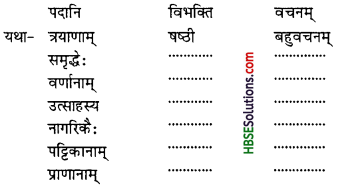
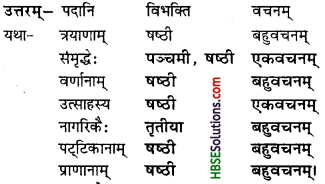
![]()
![]()


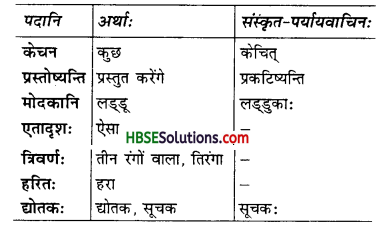
![]()
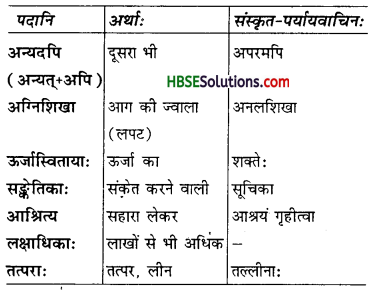
![]()

